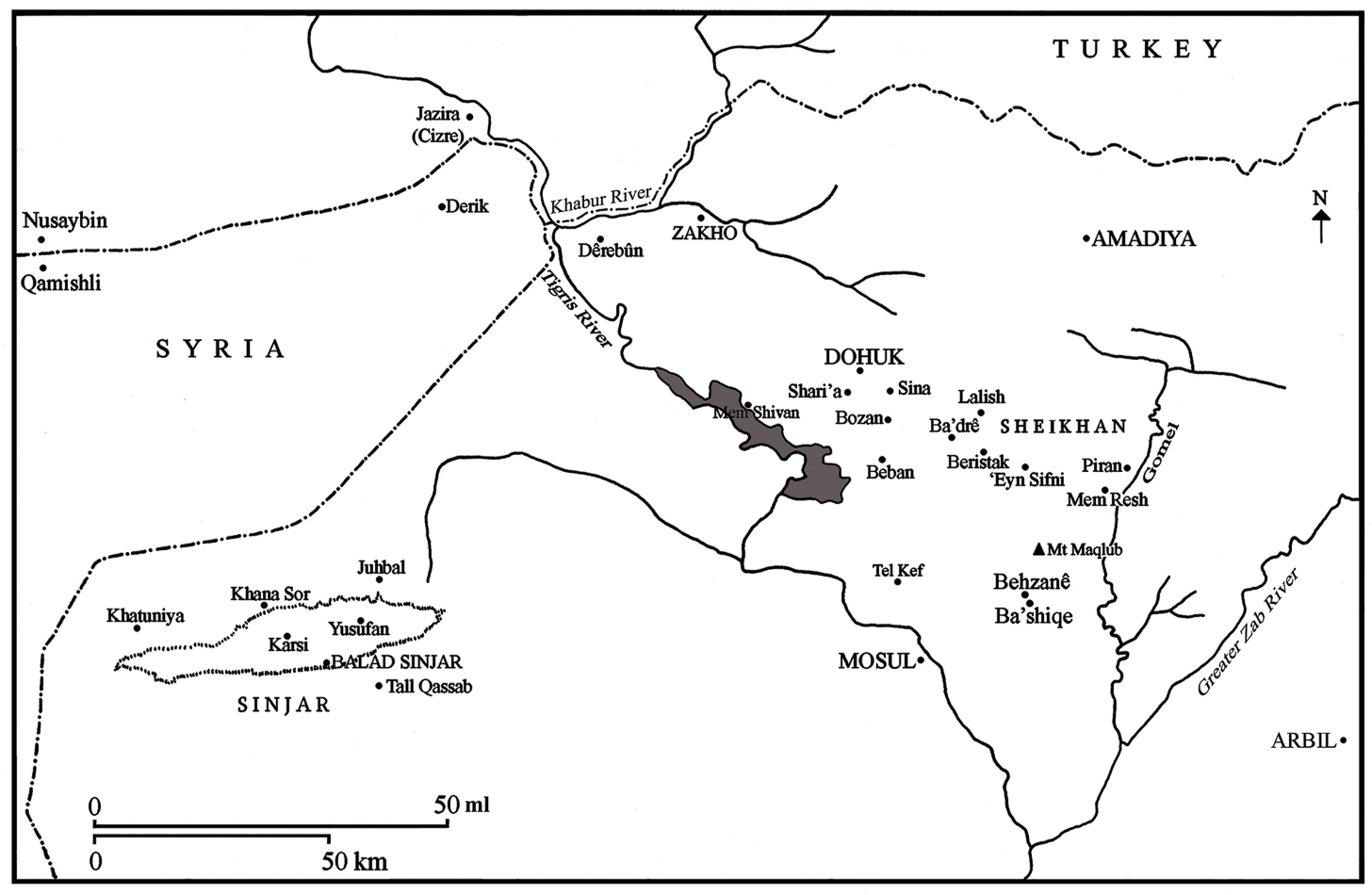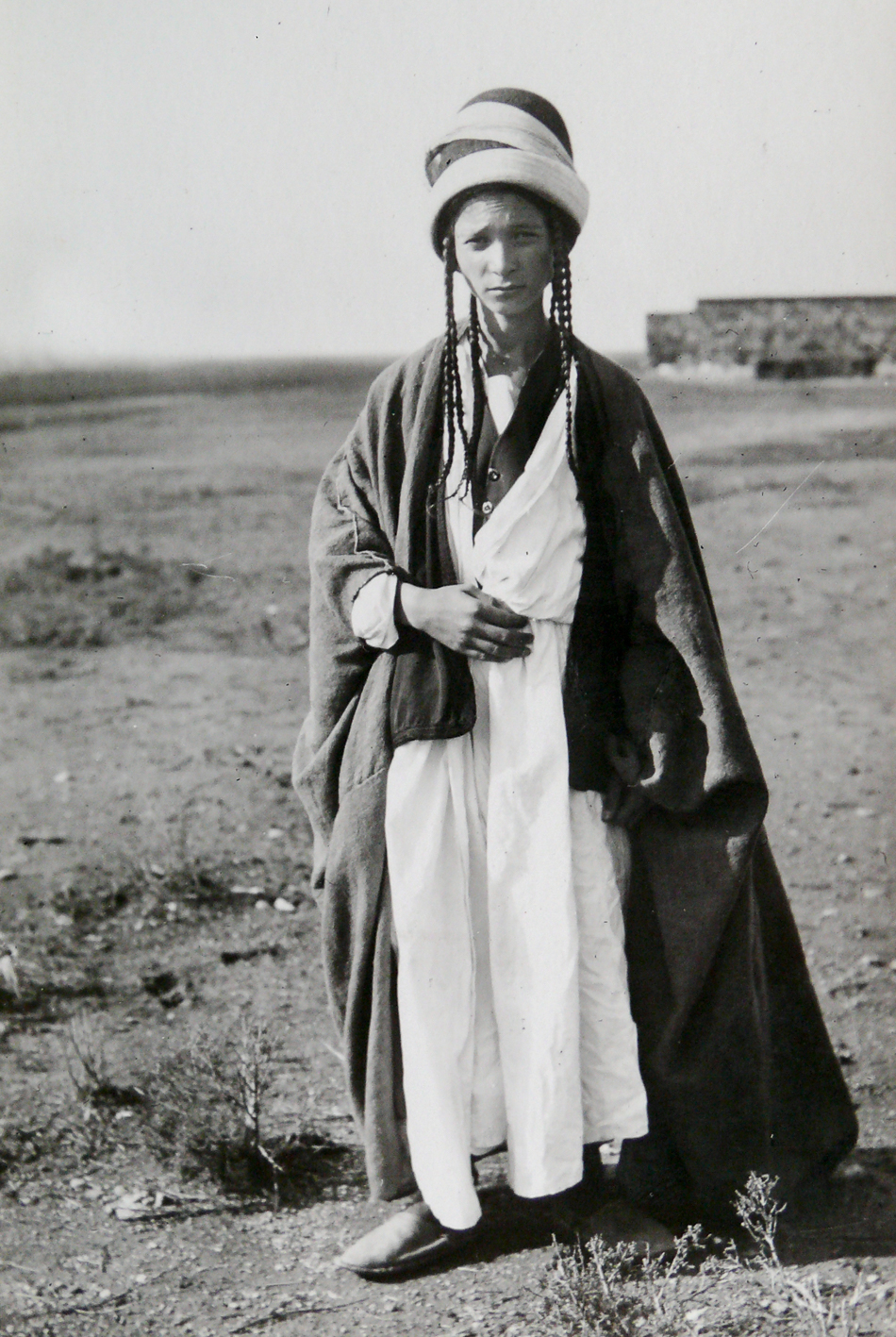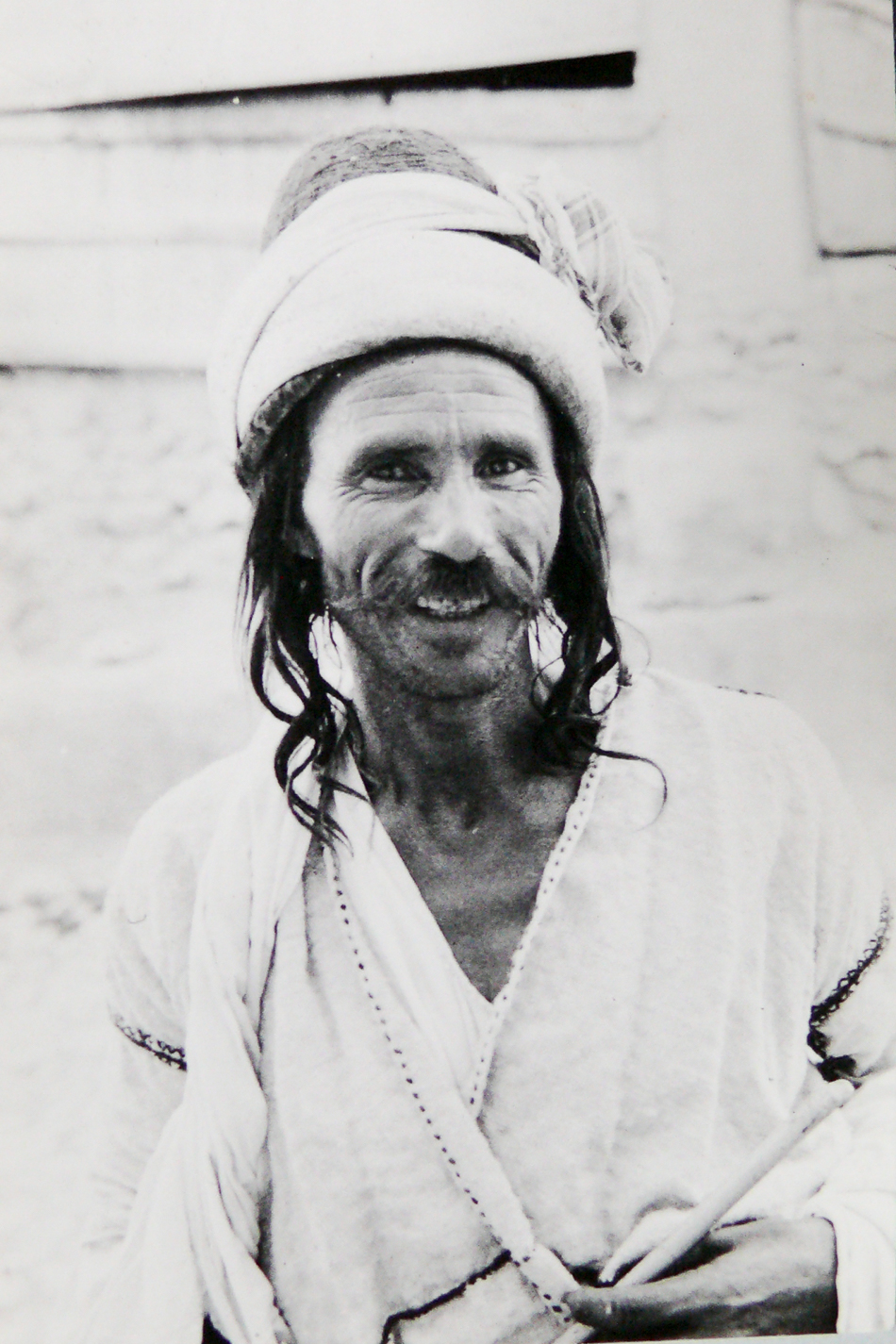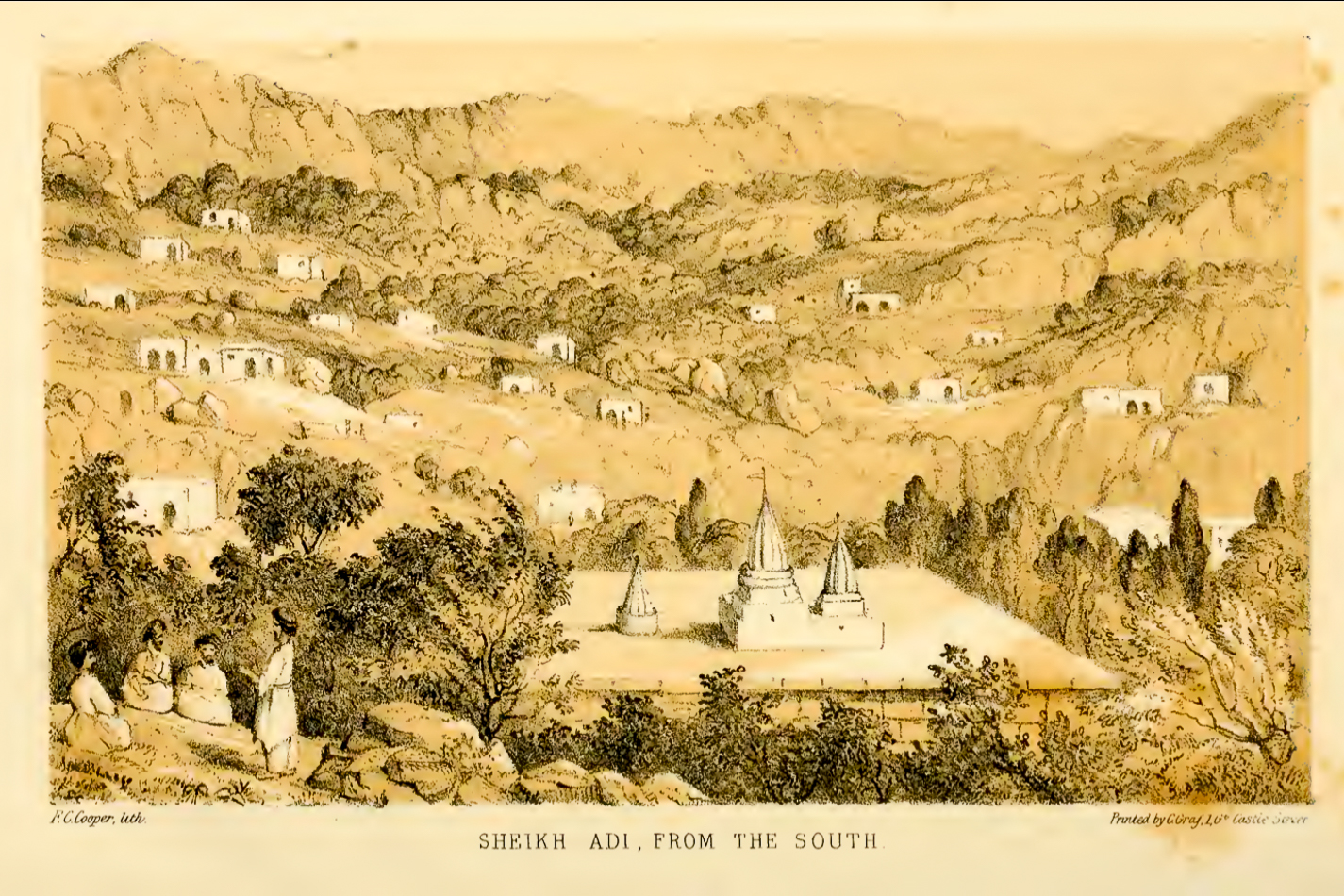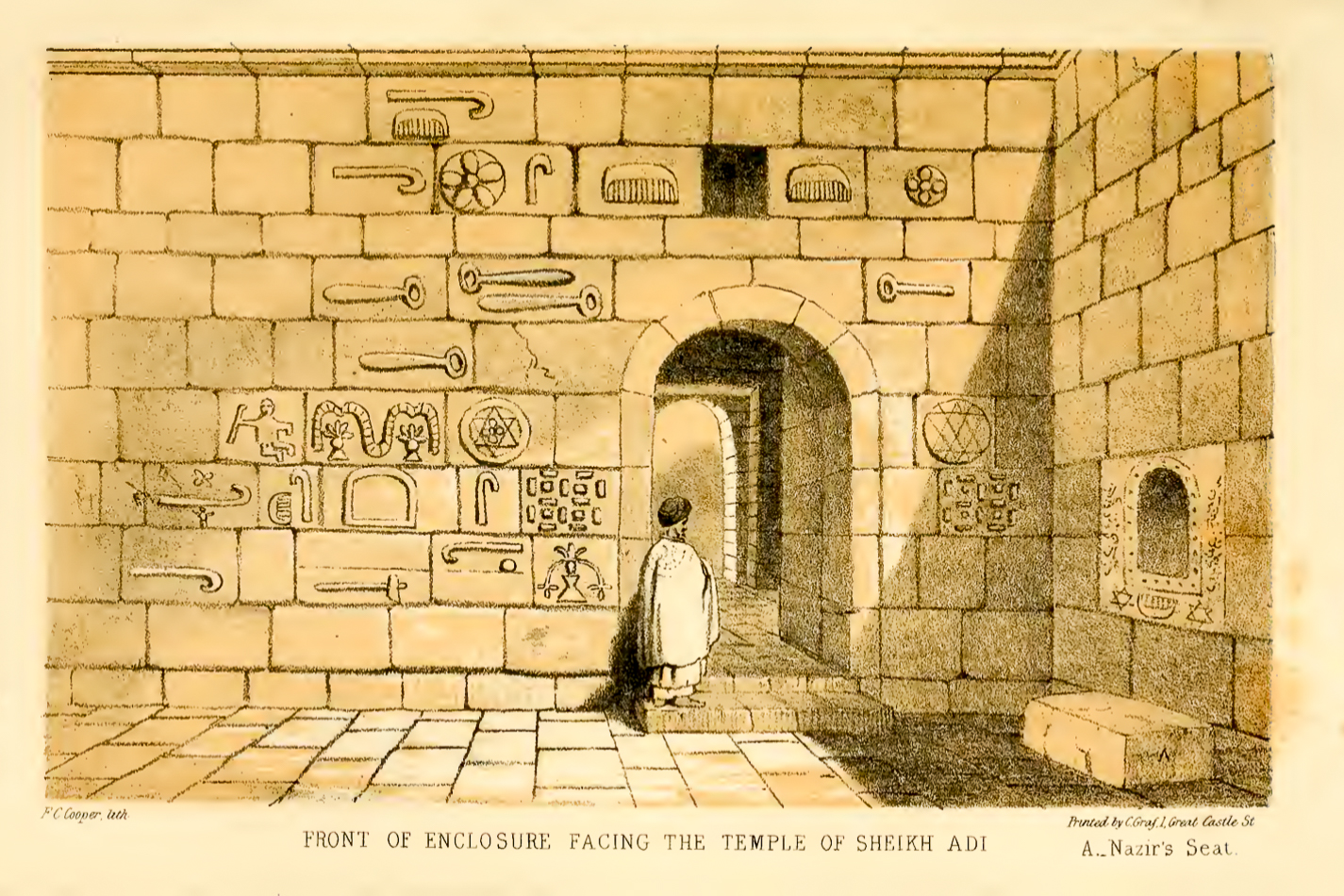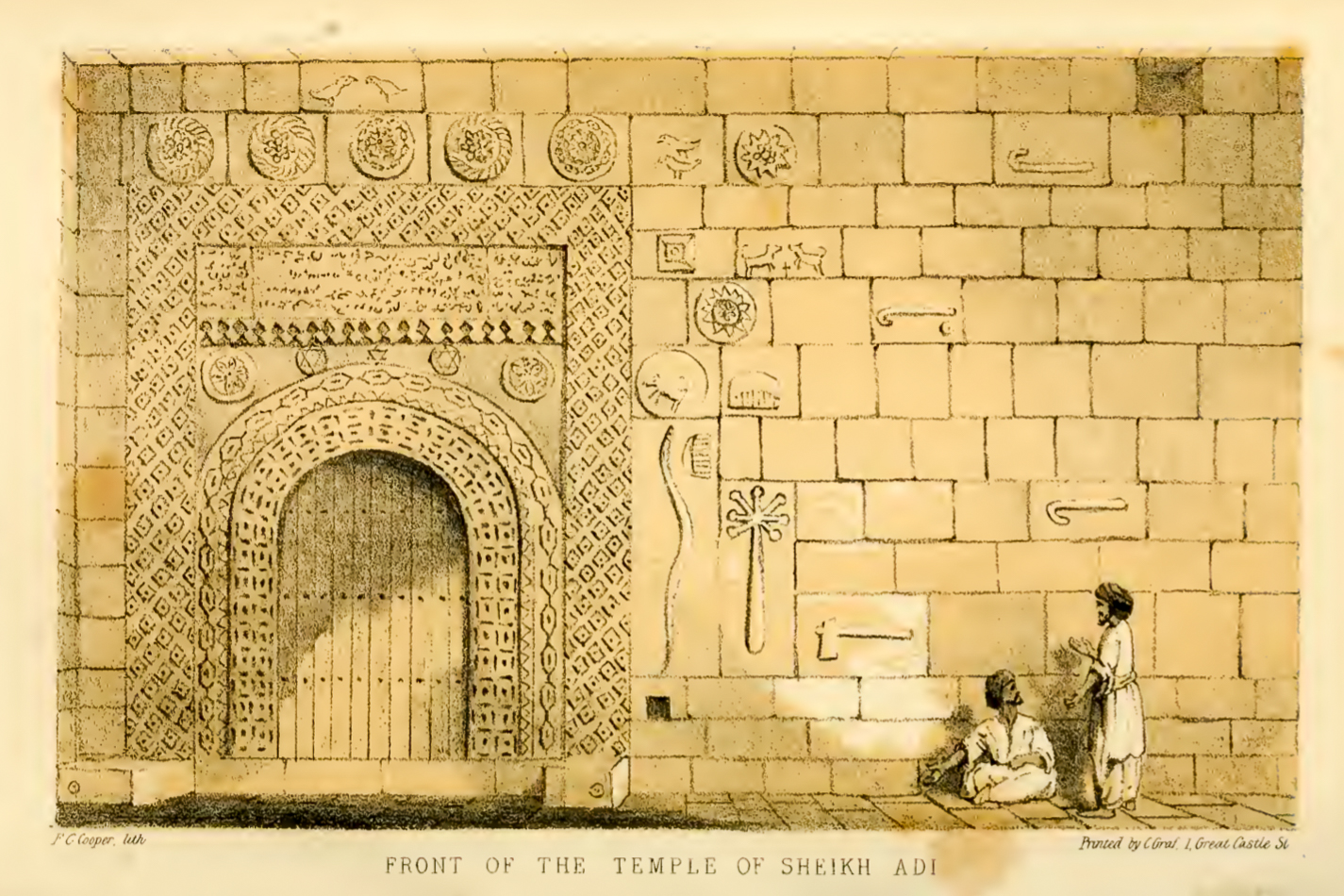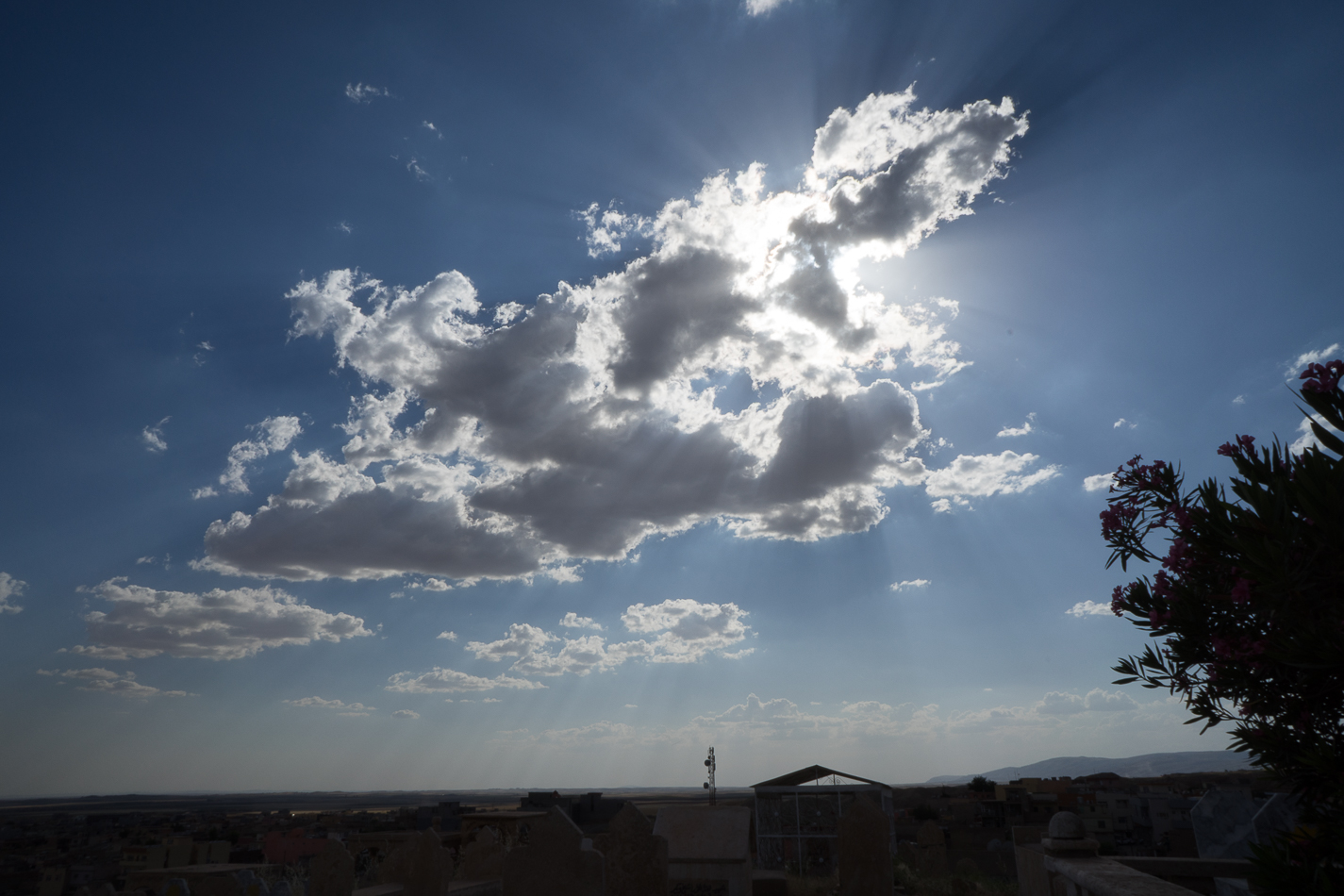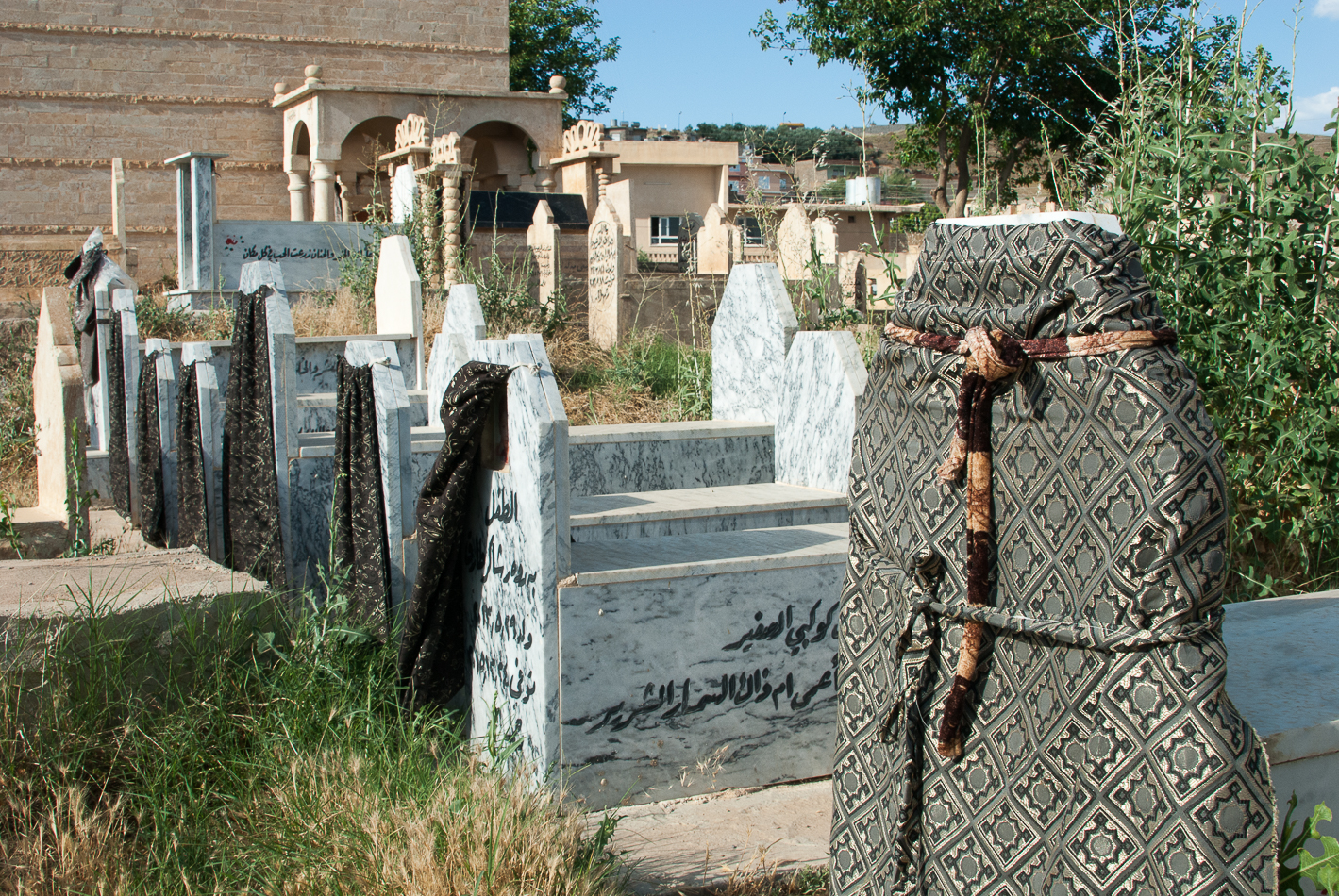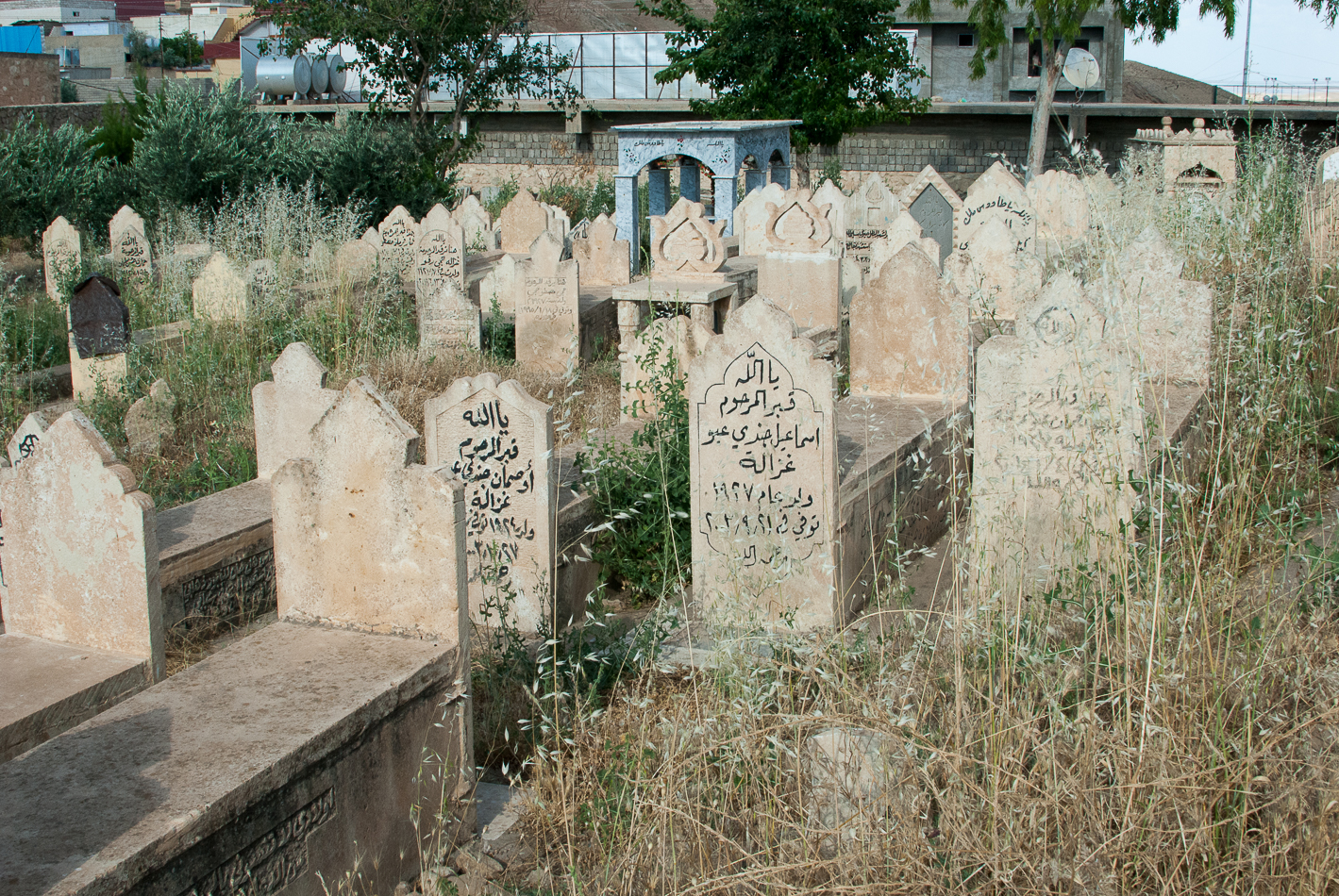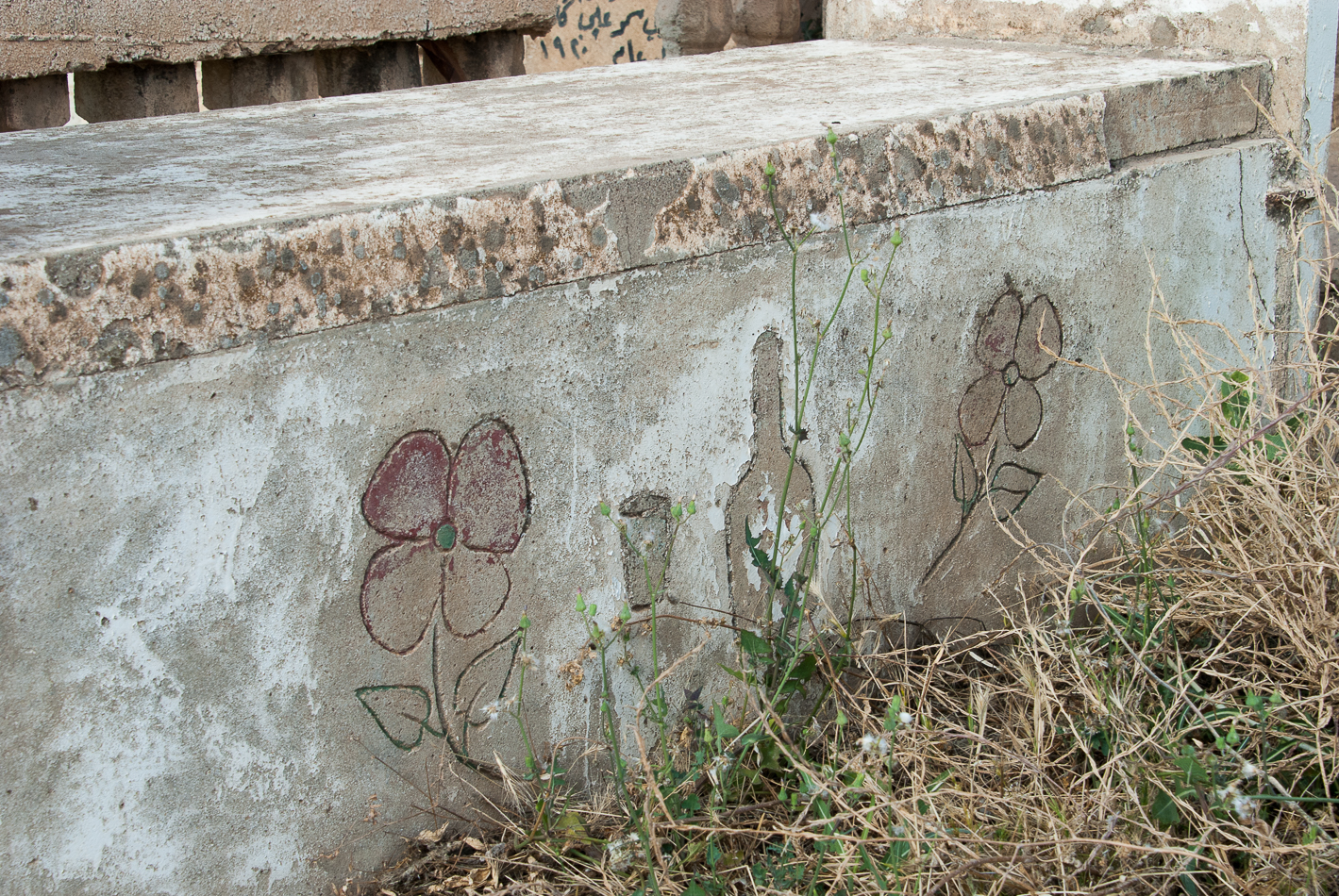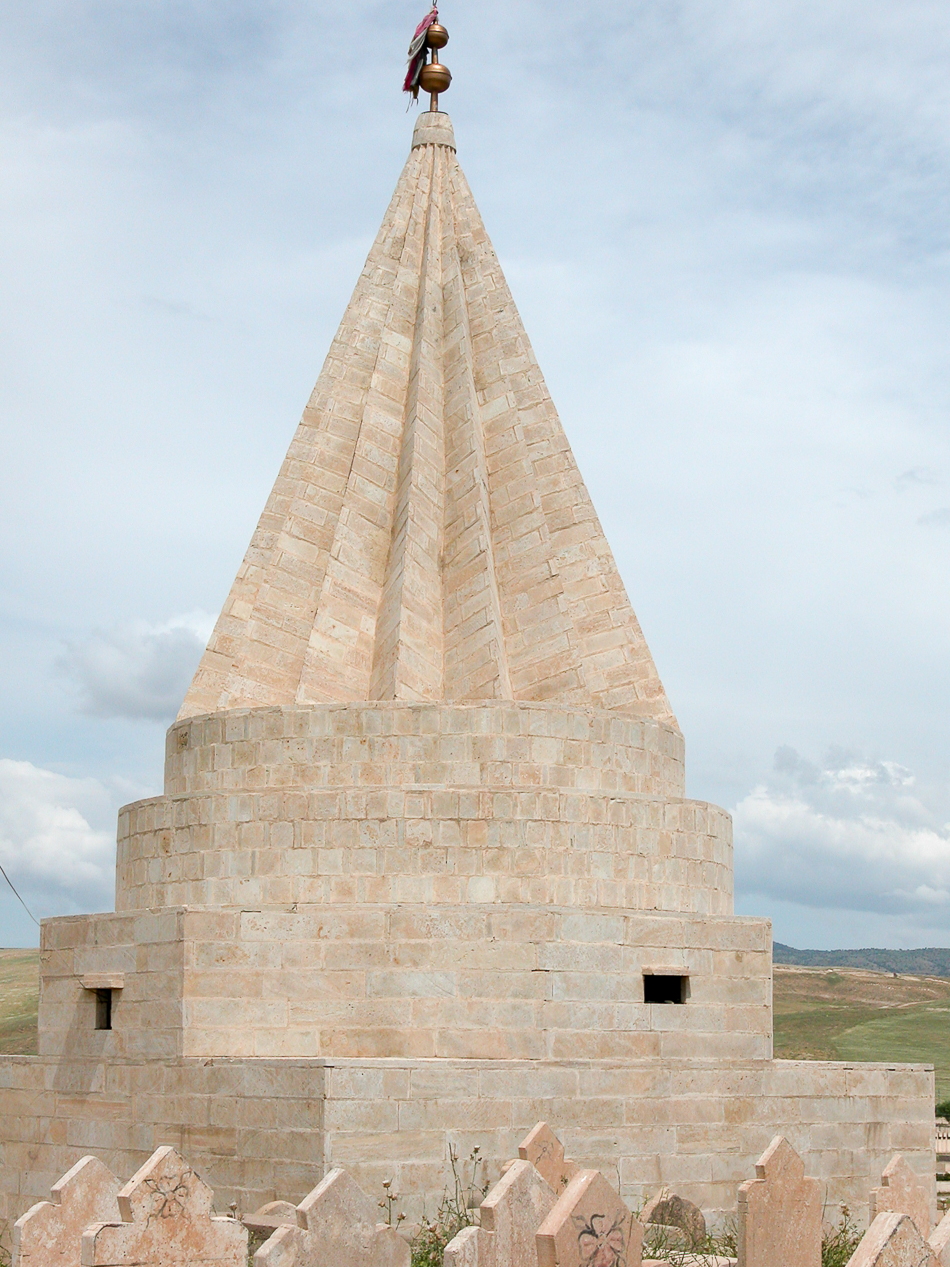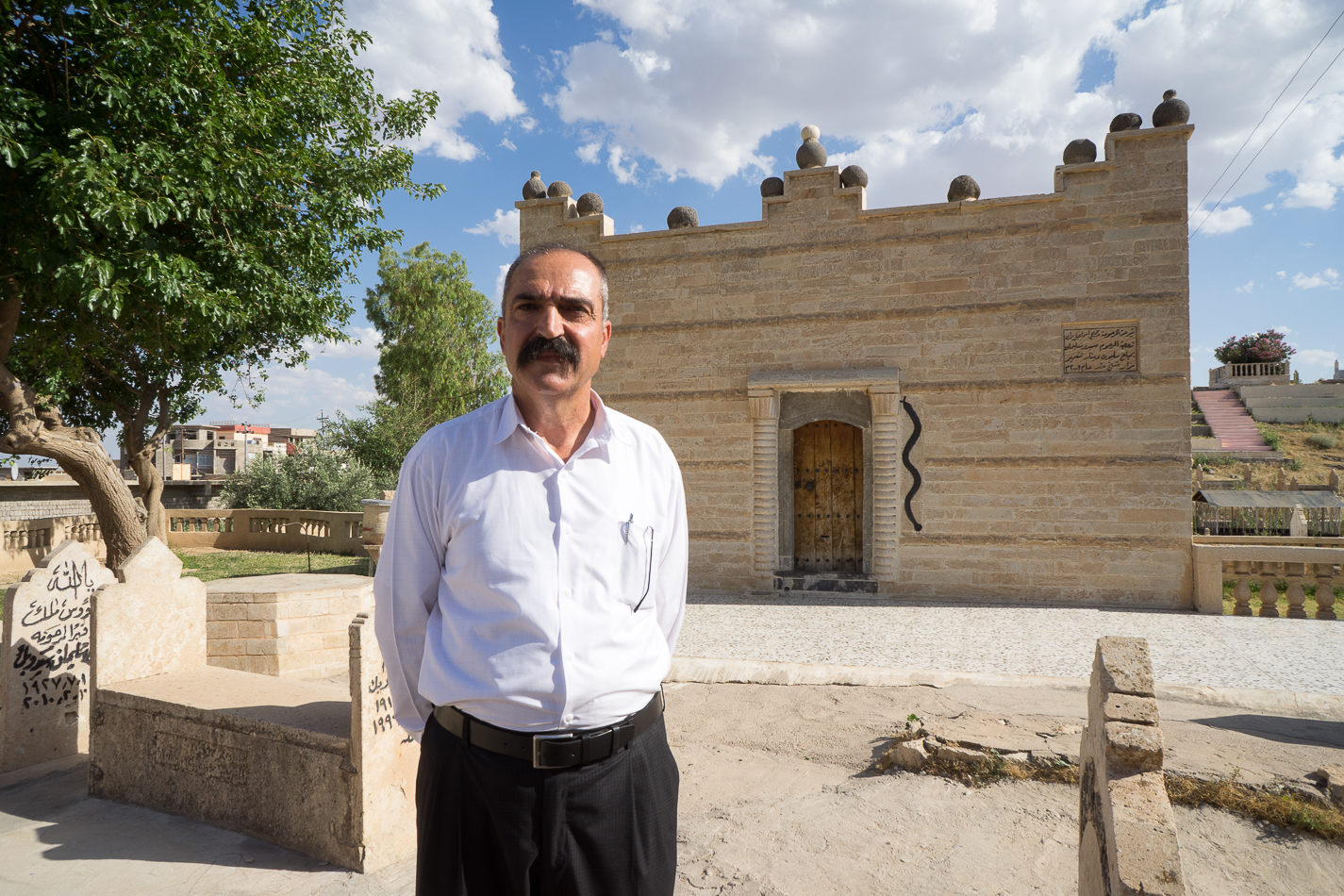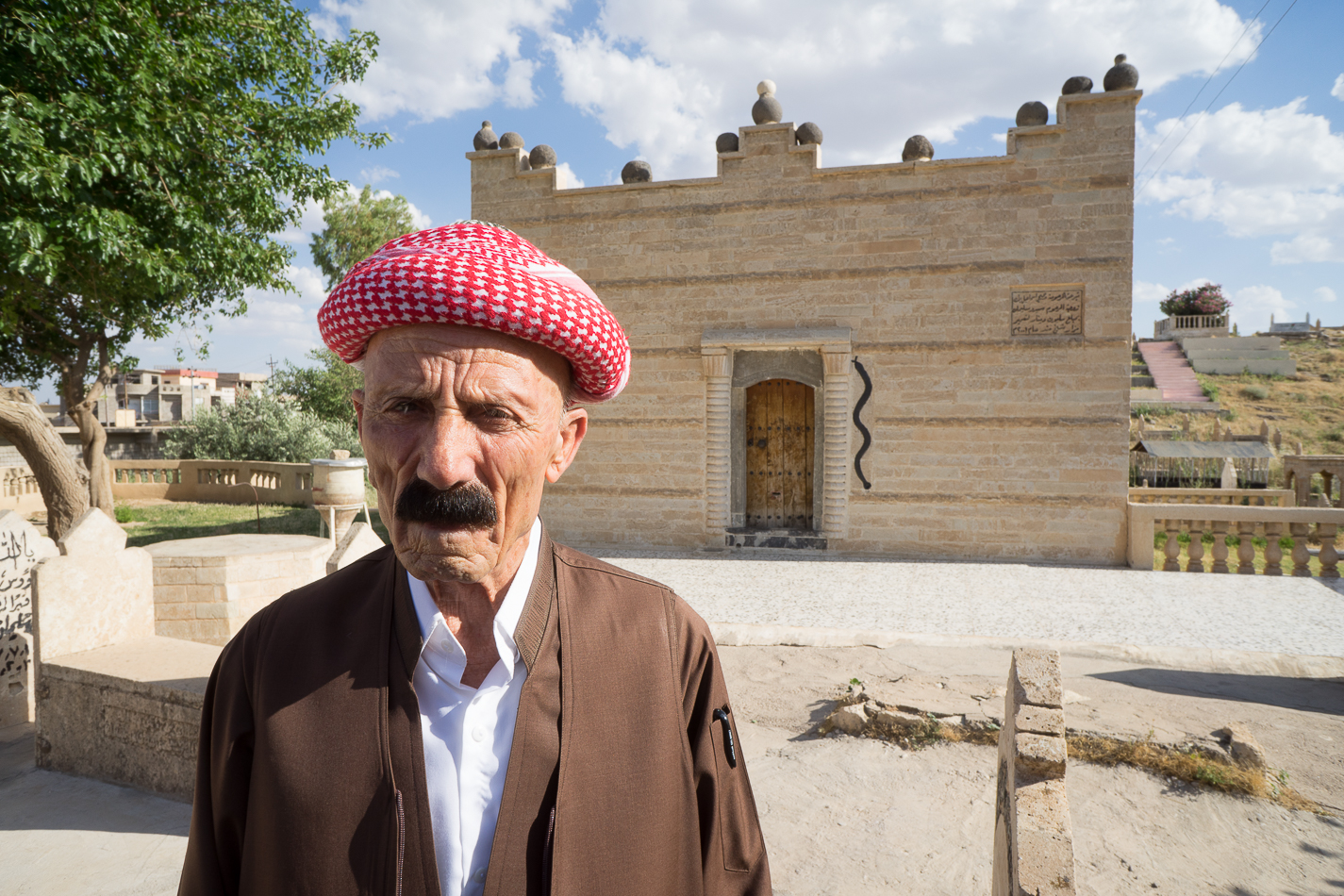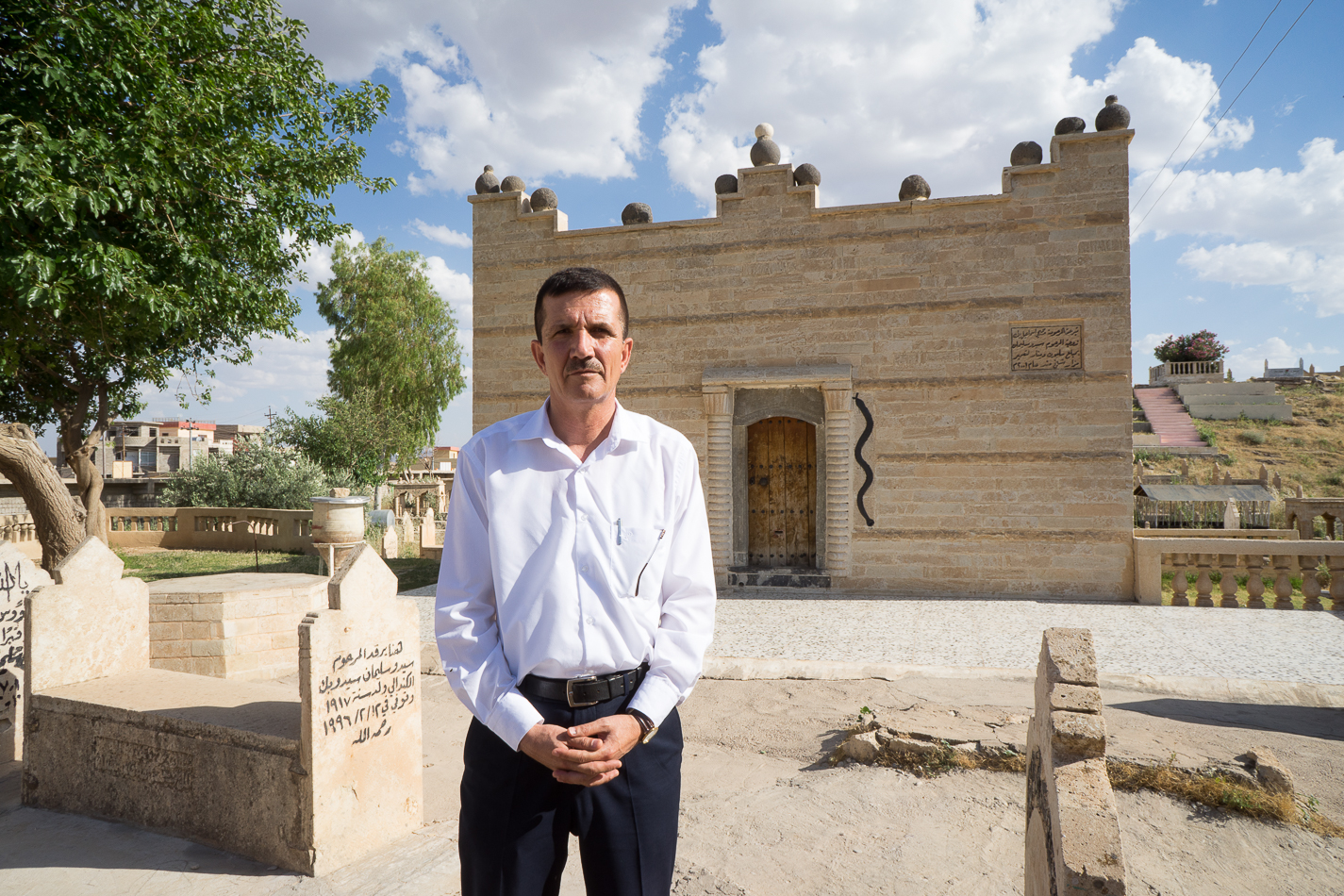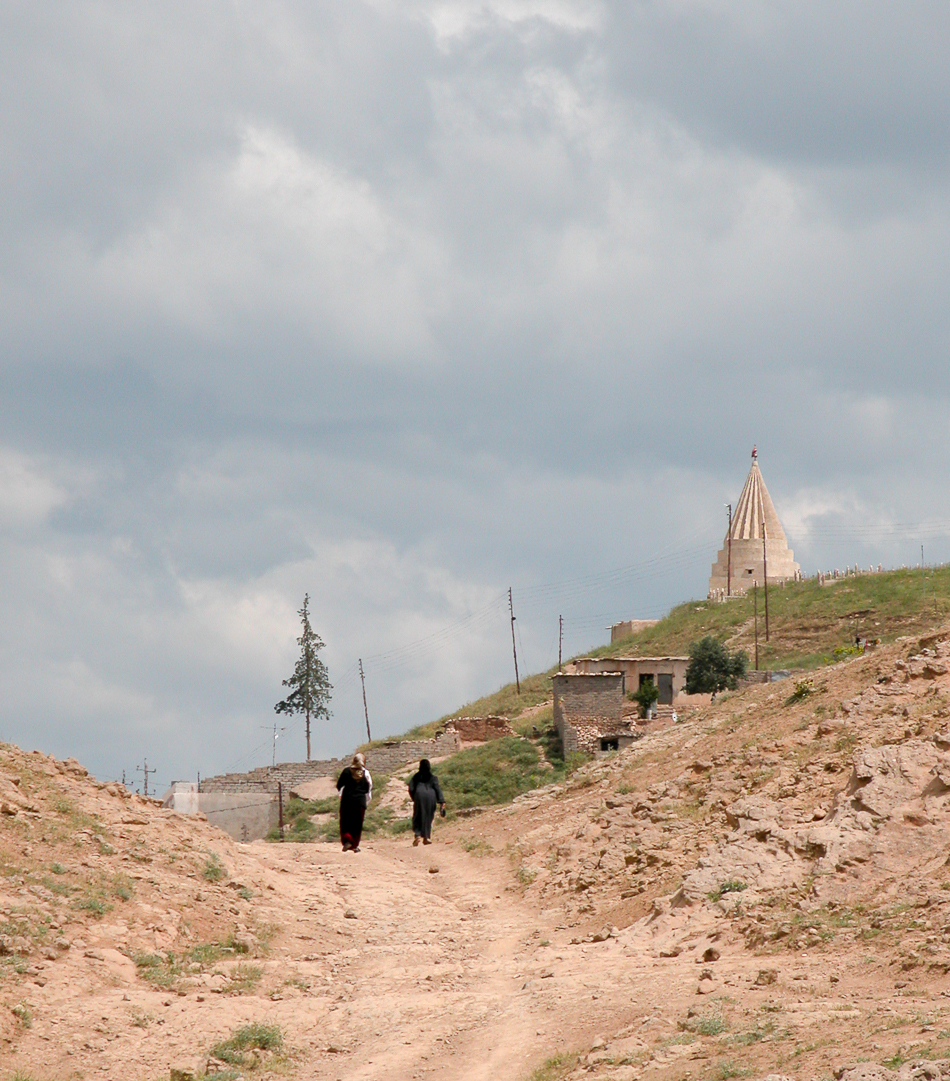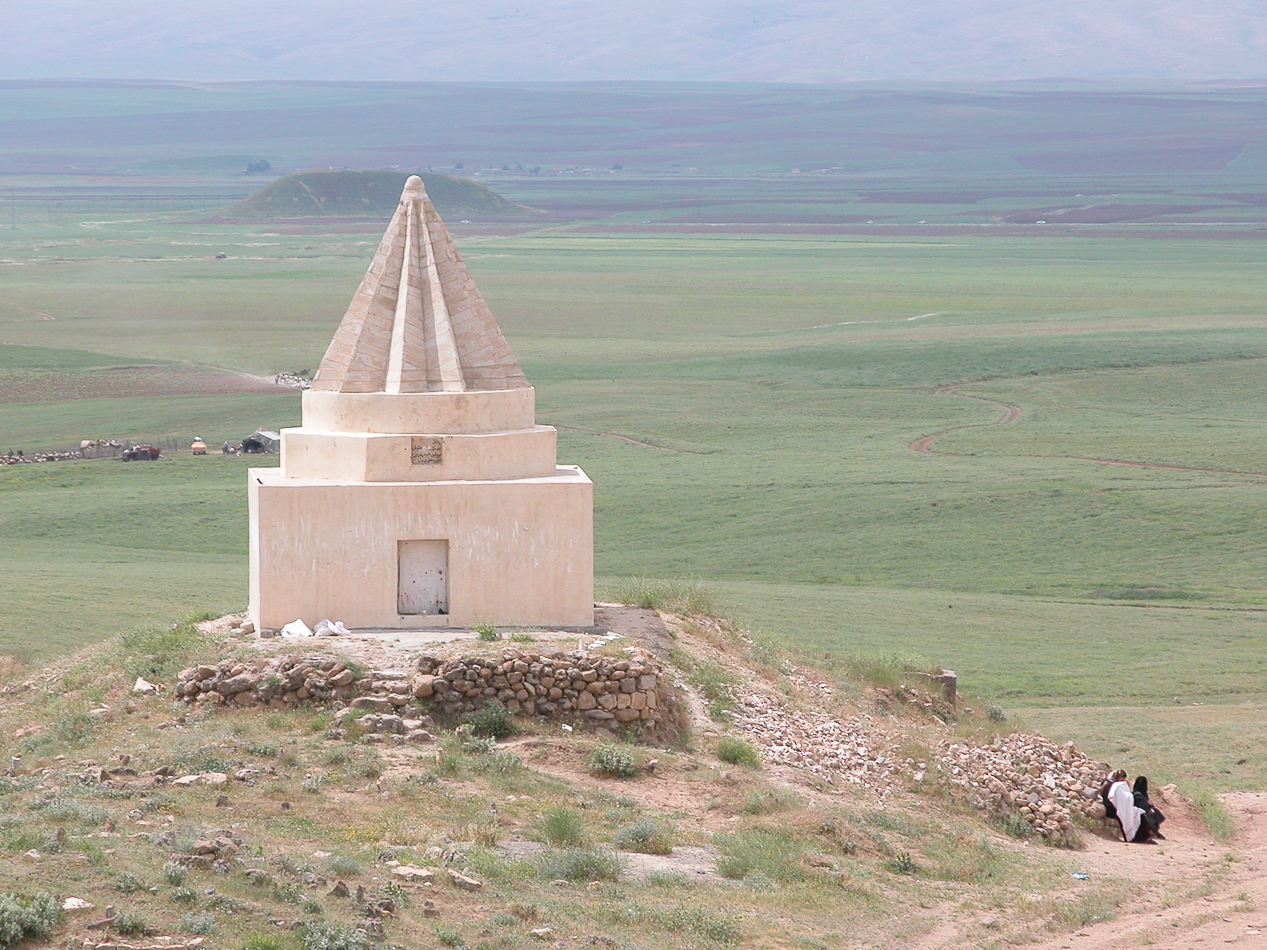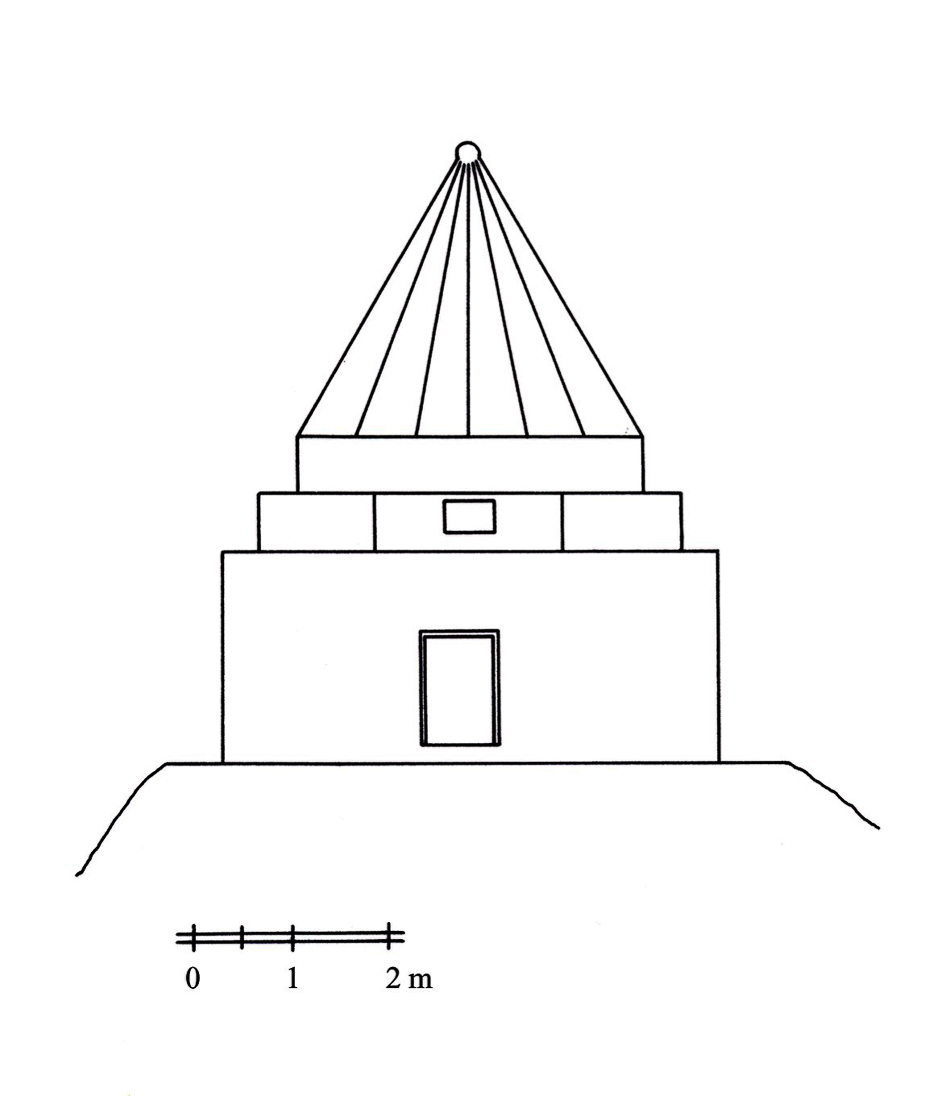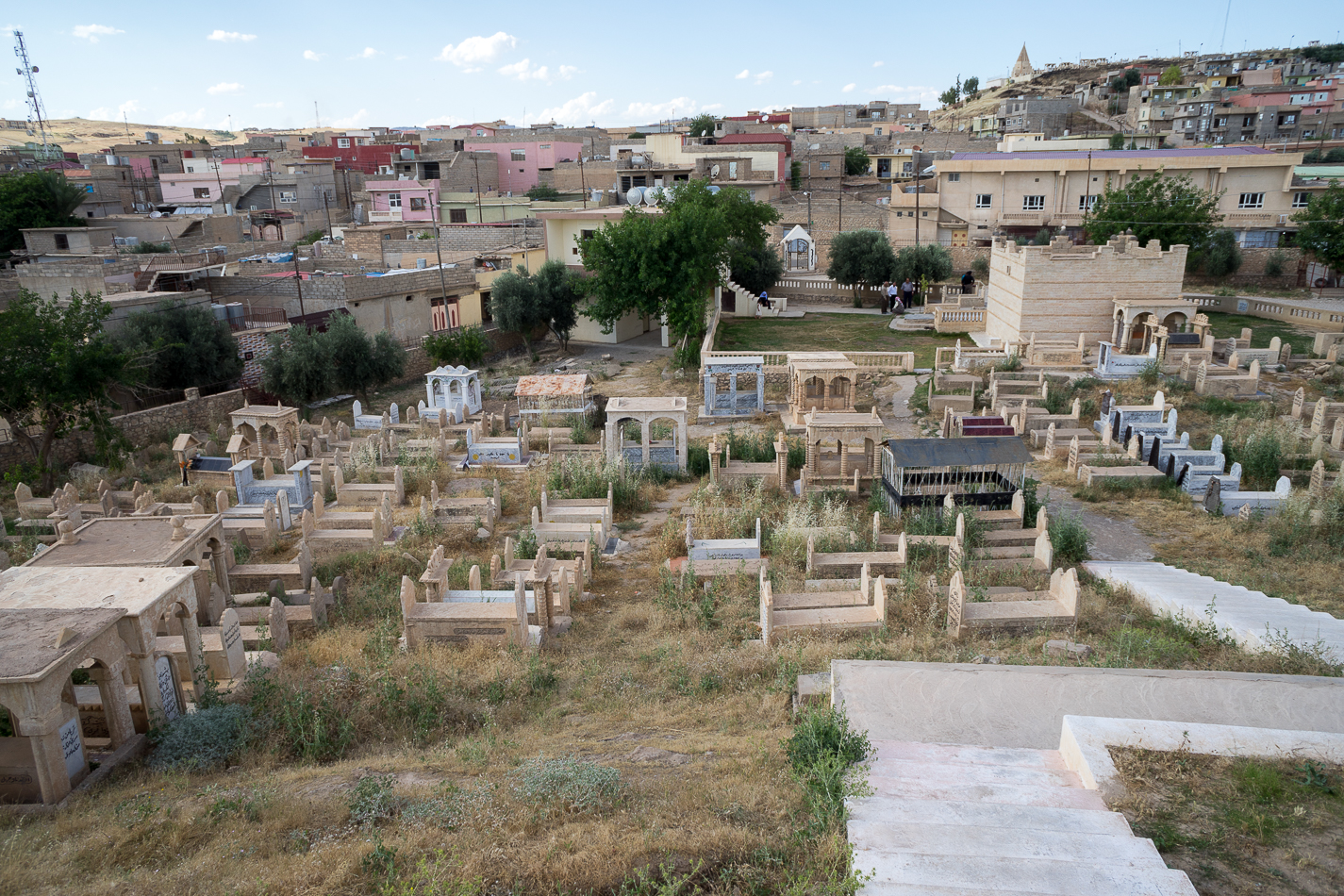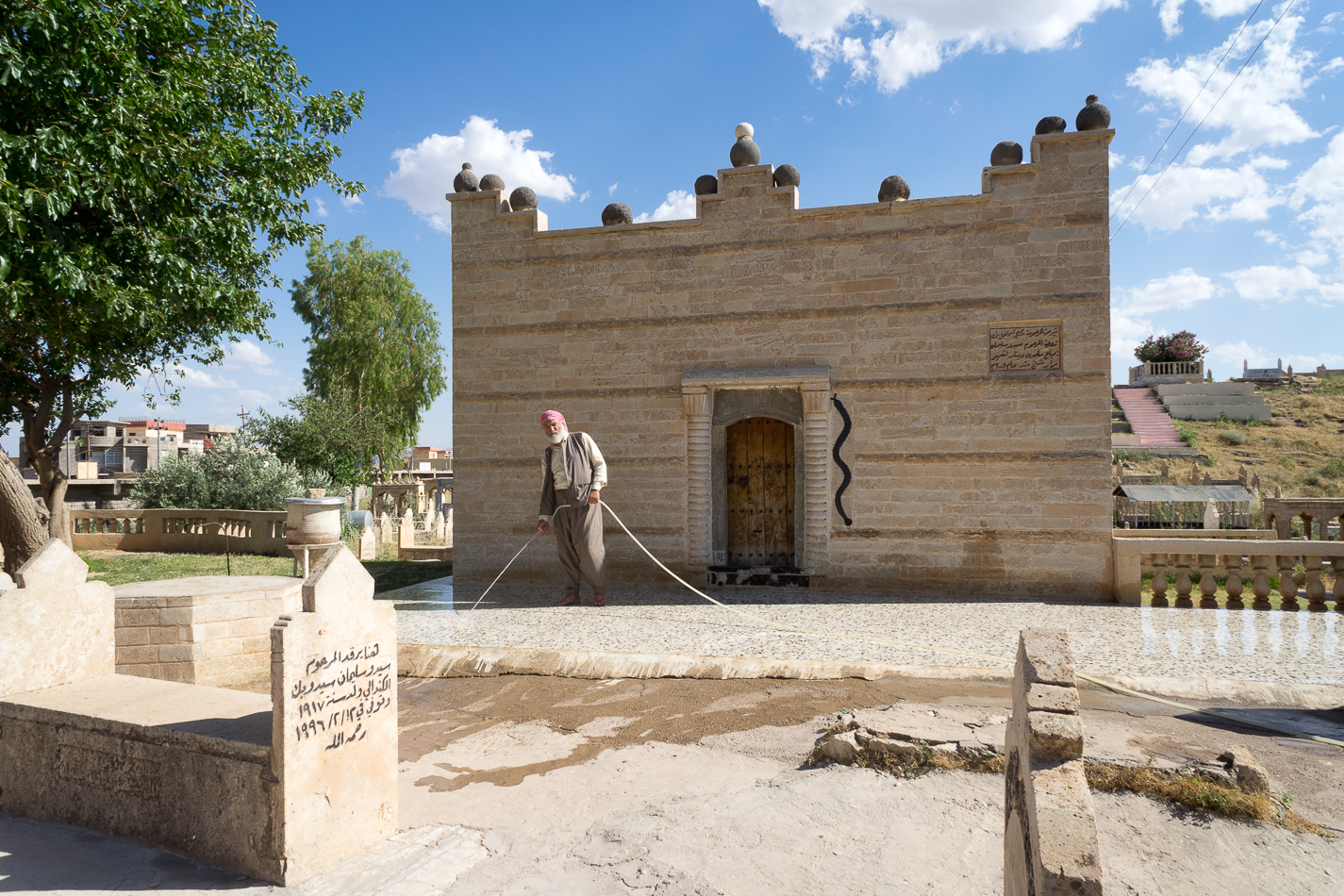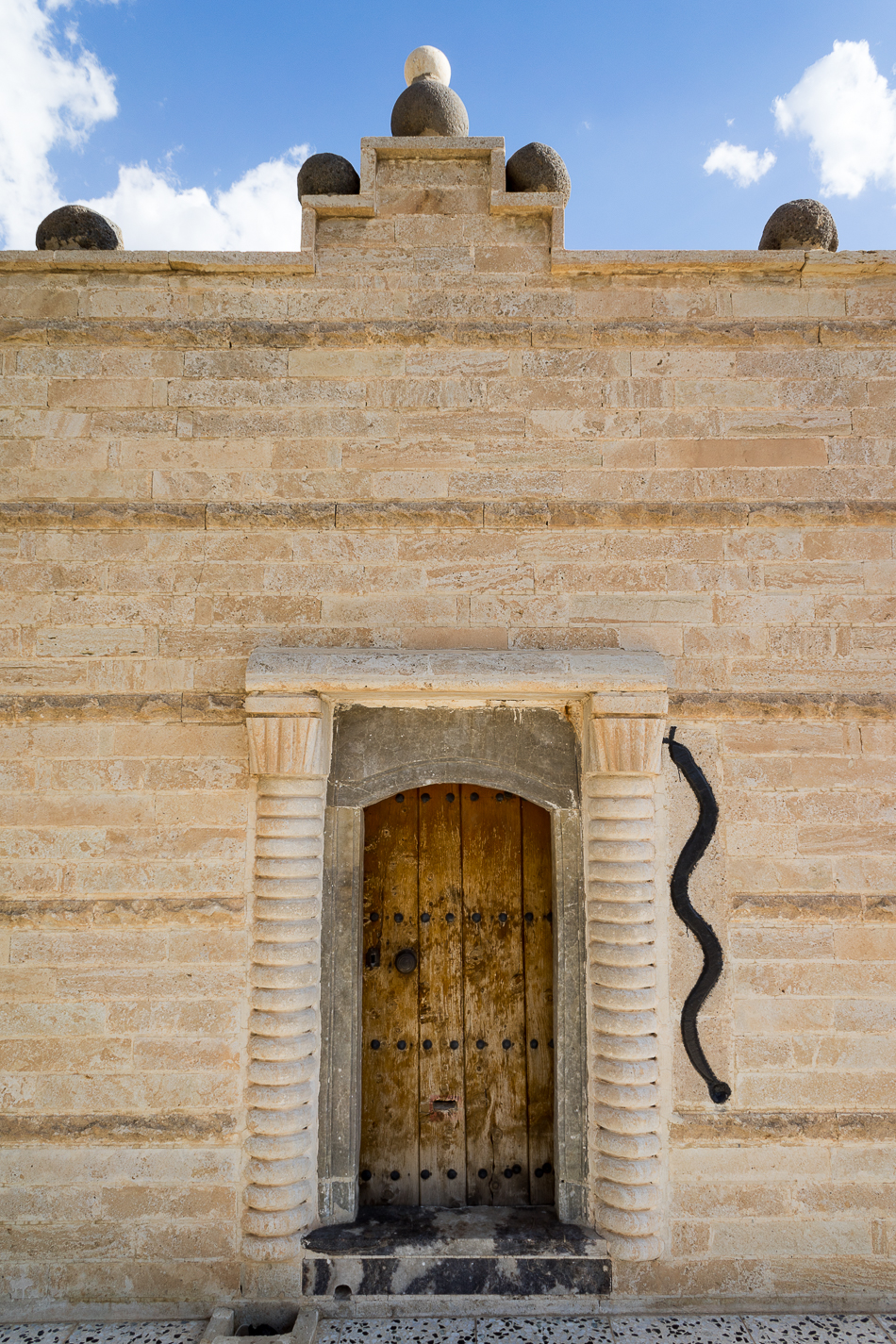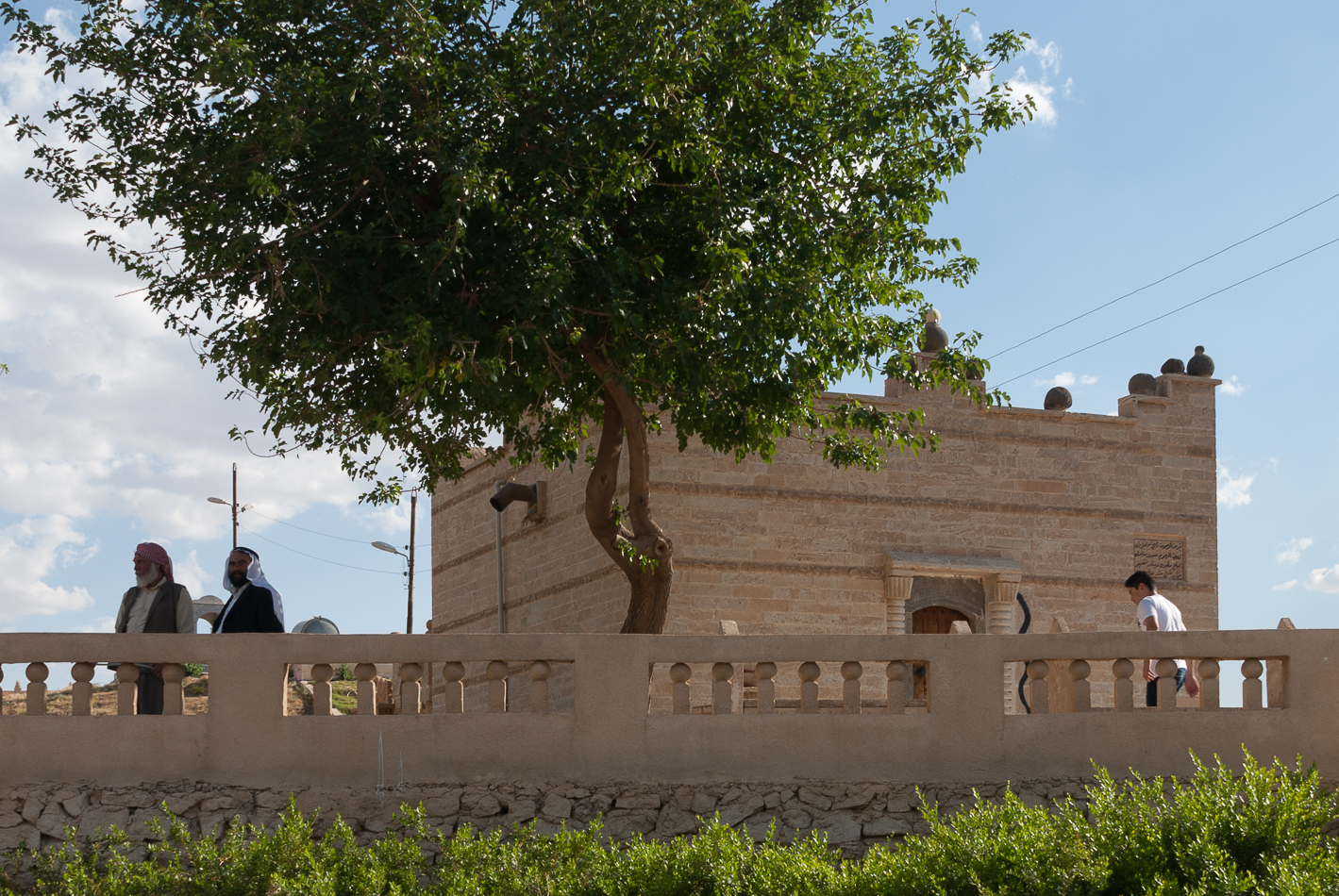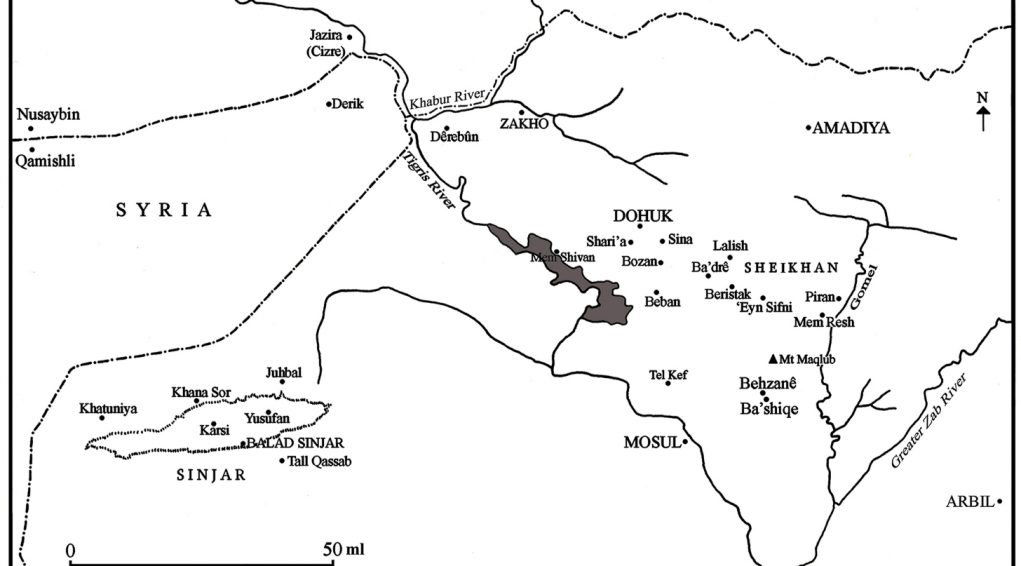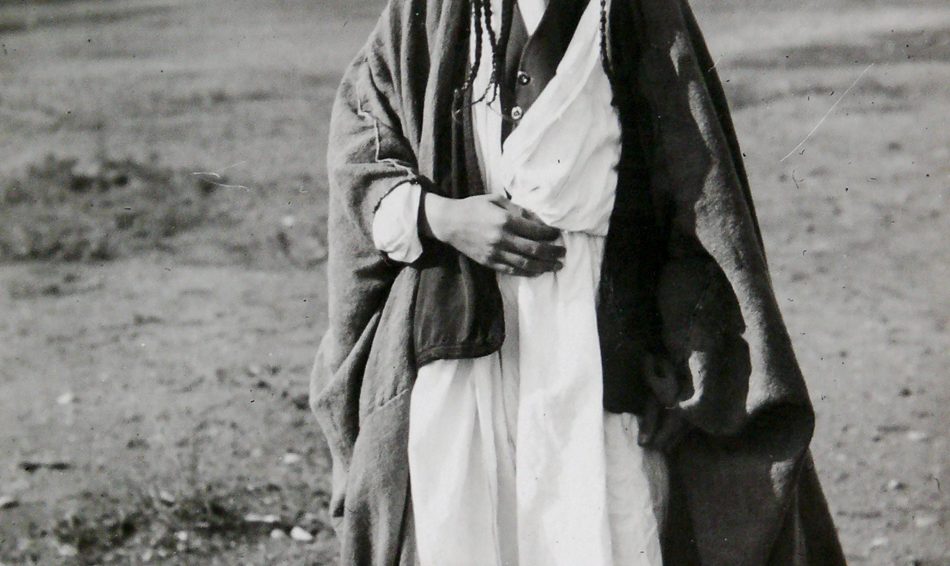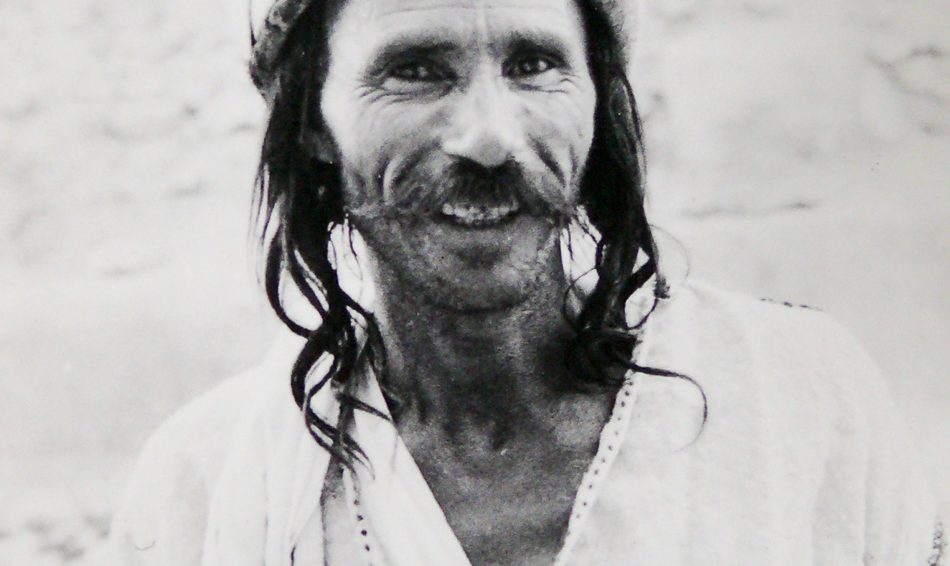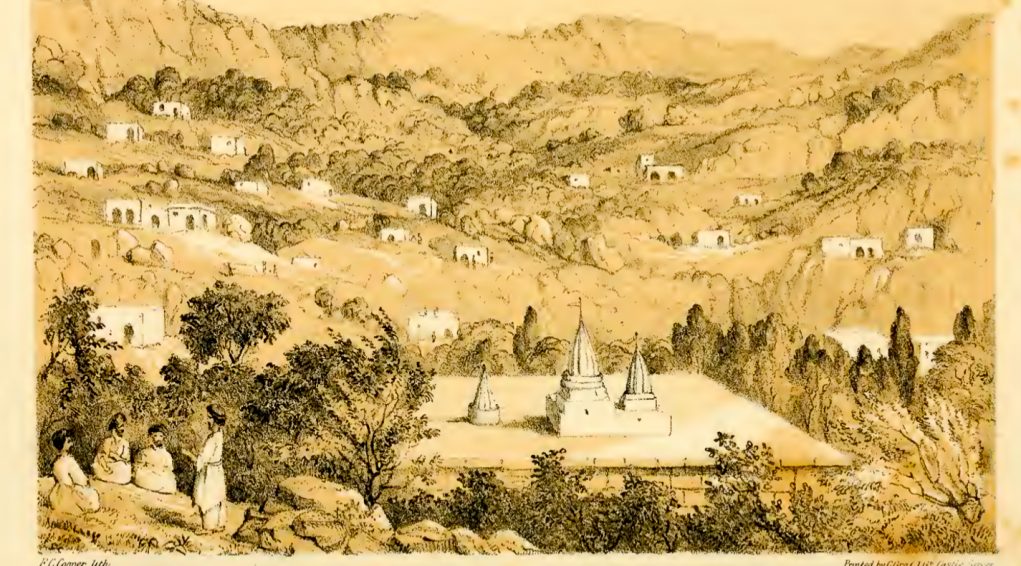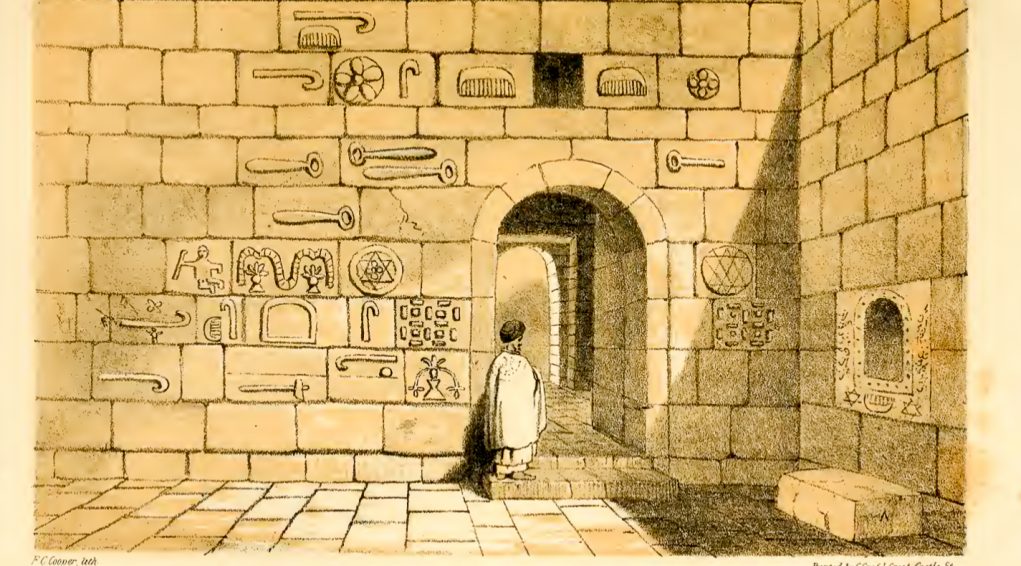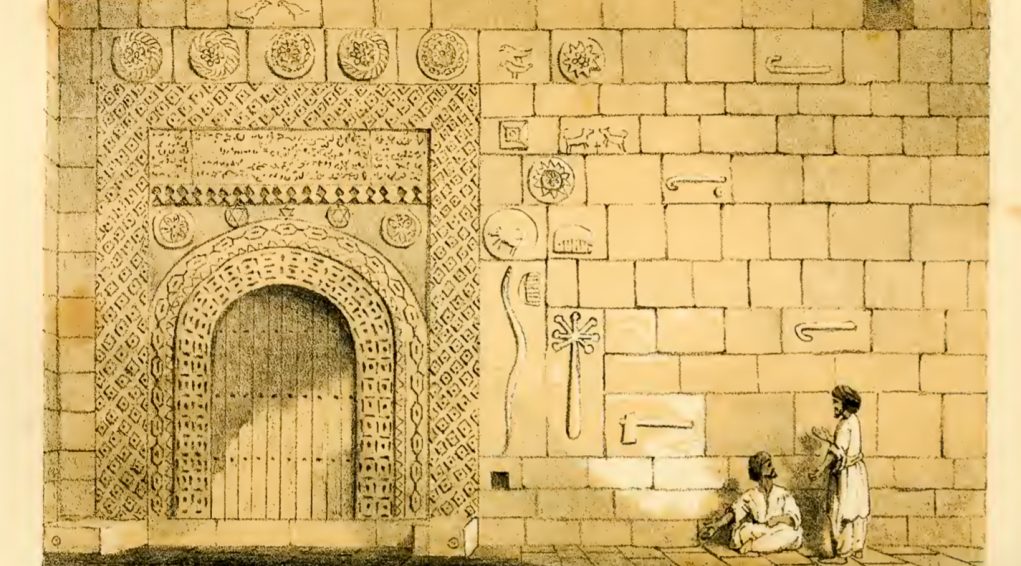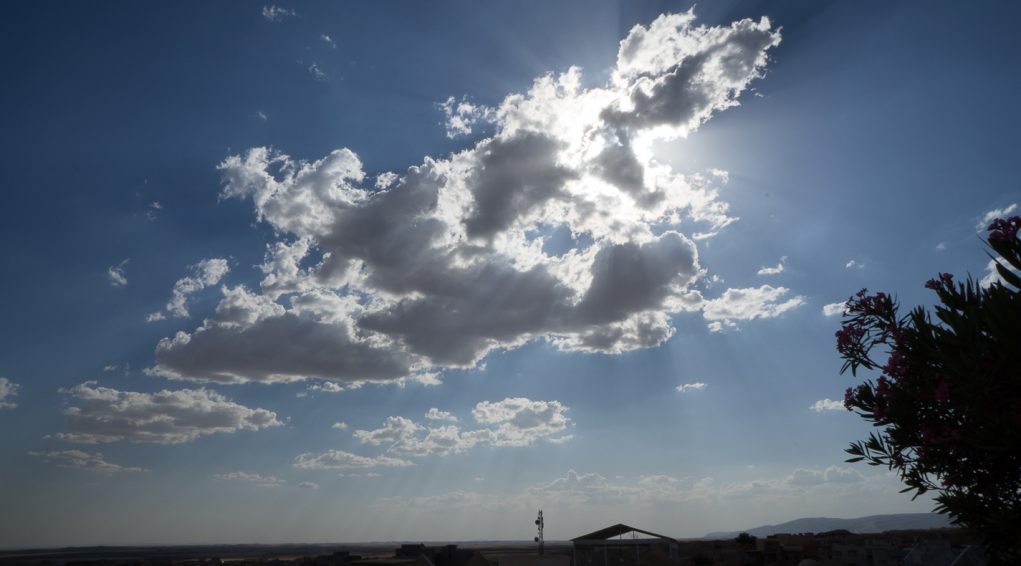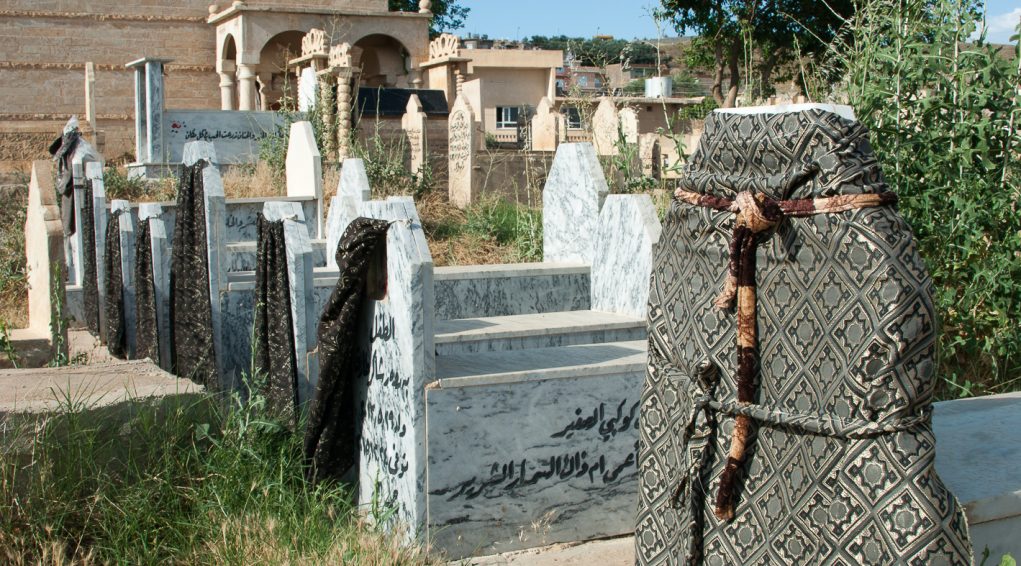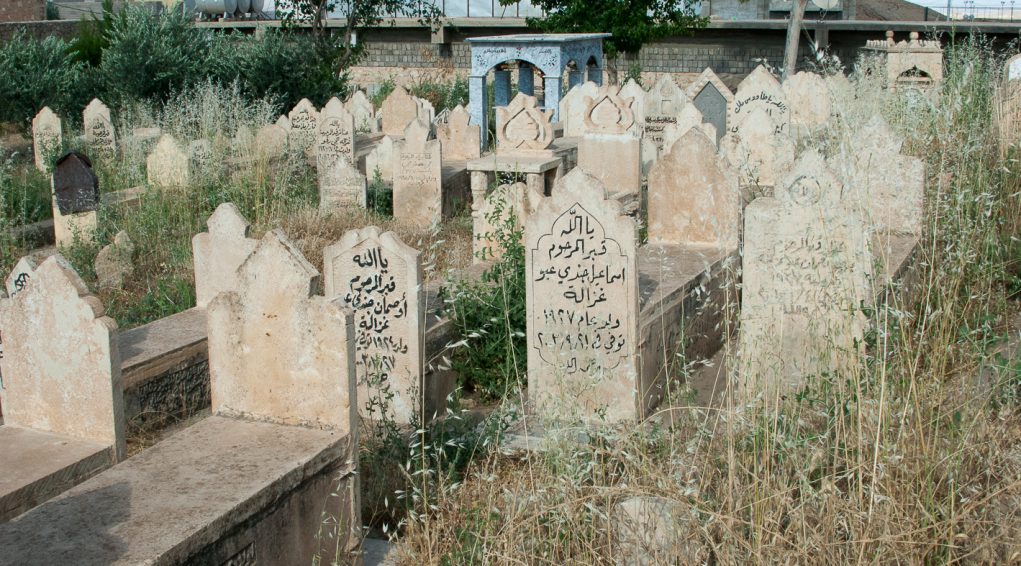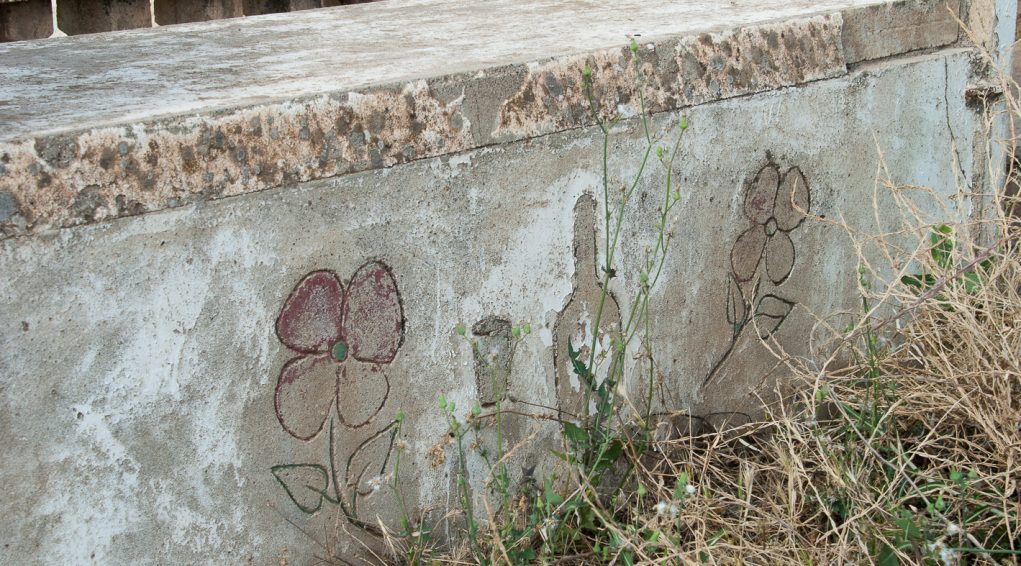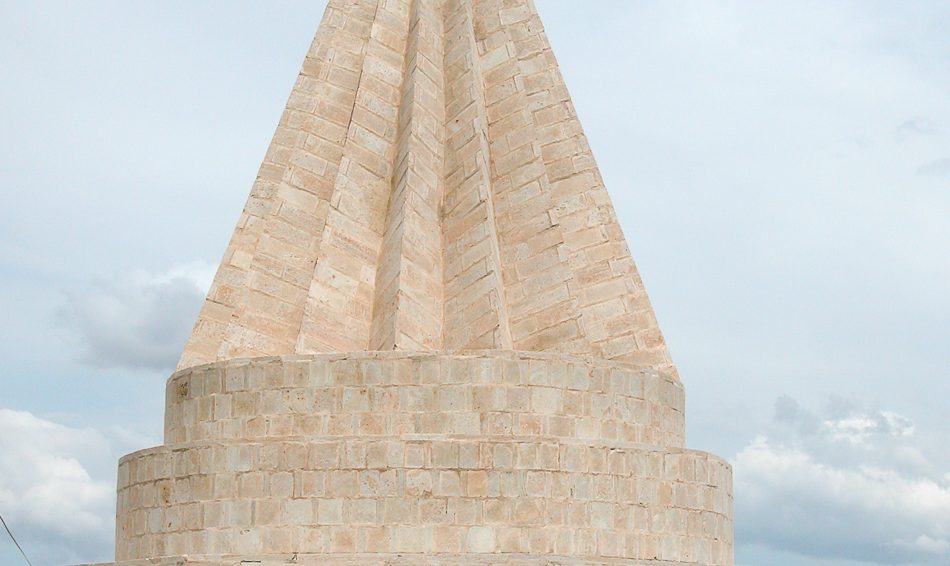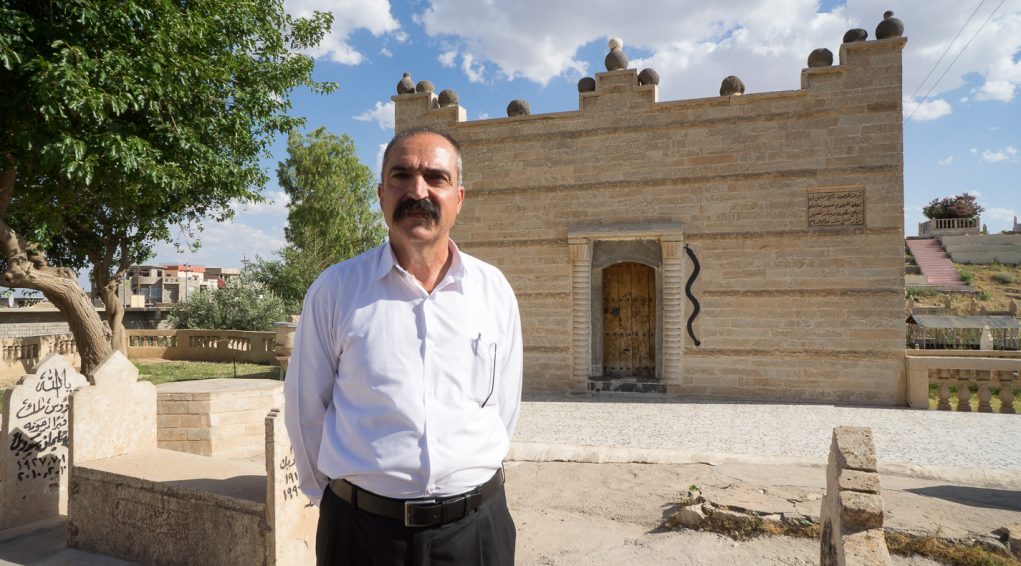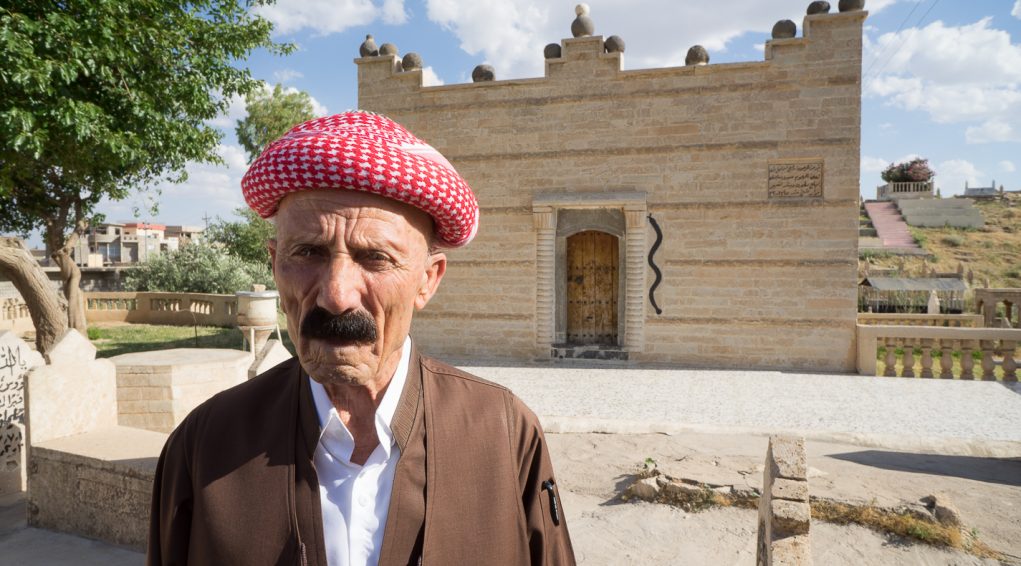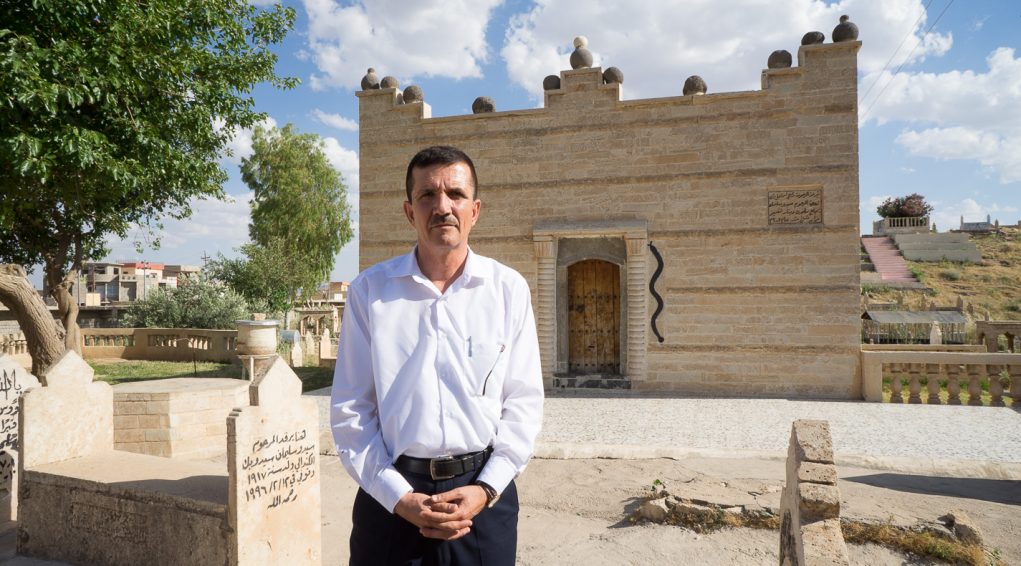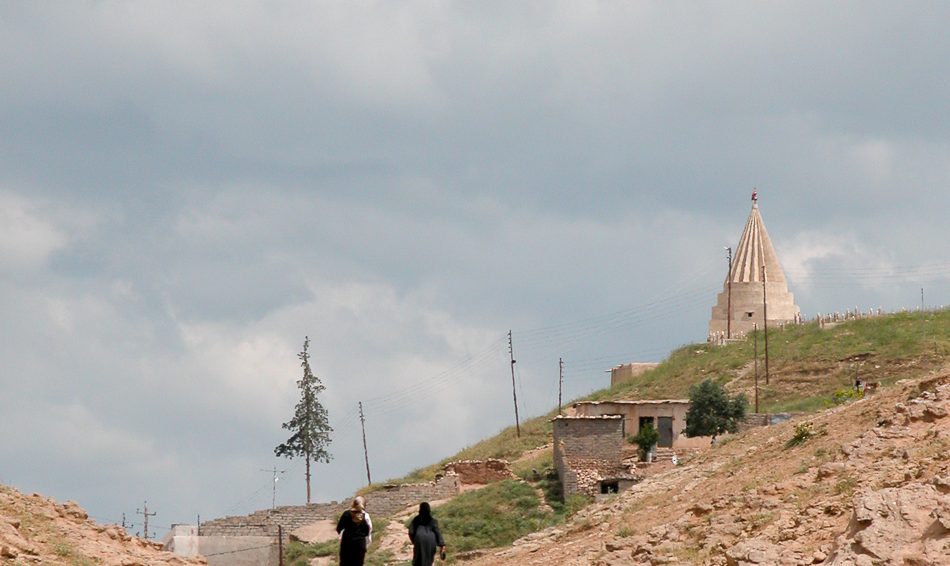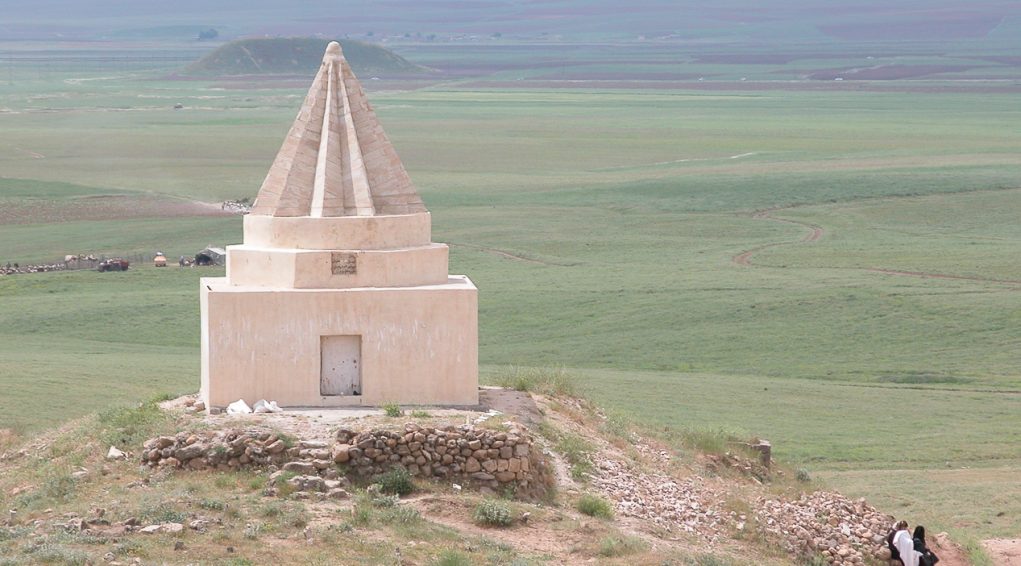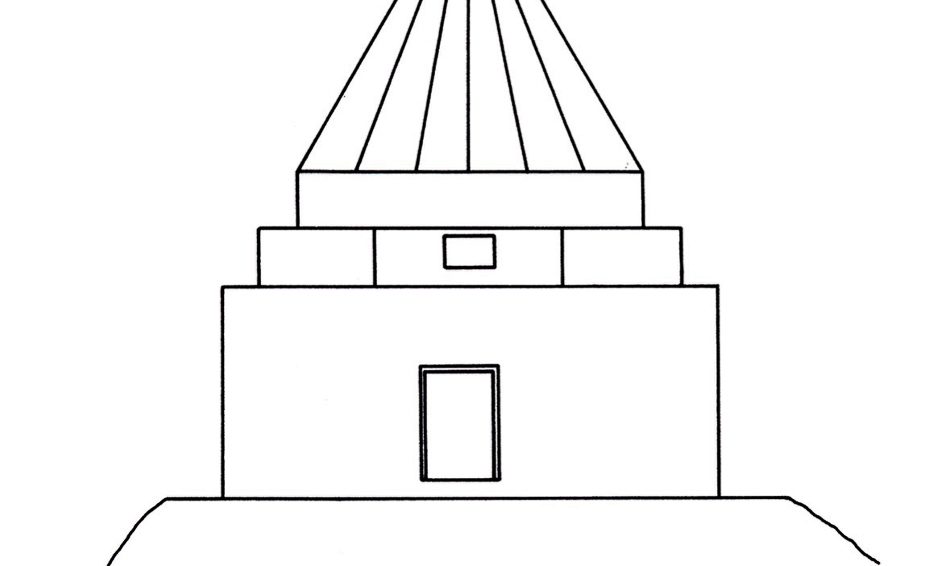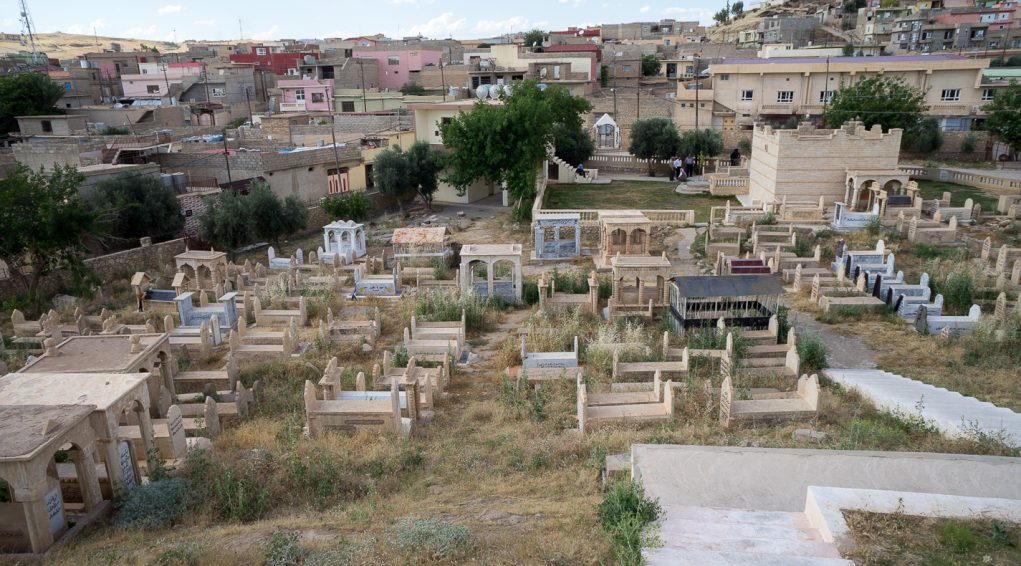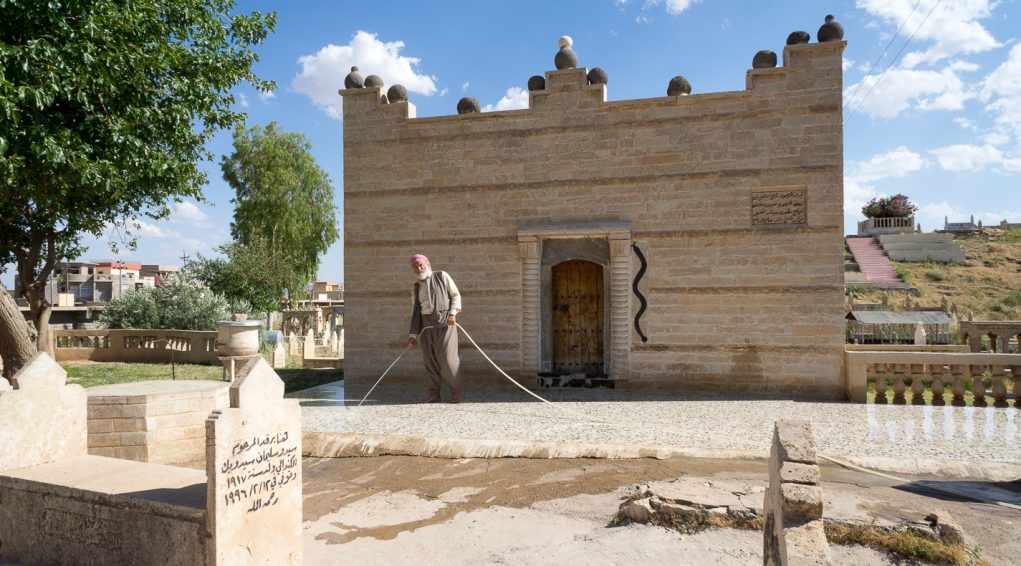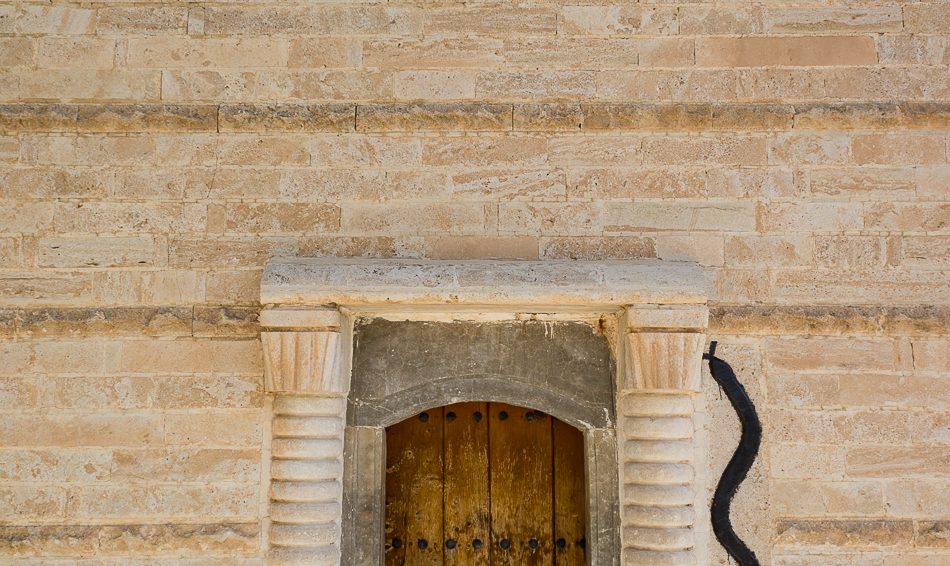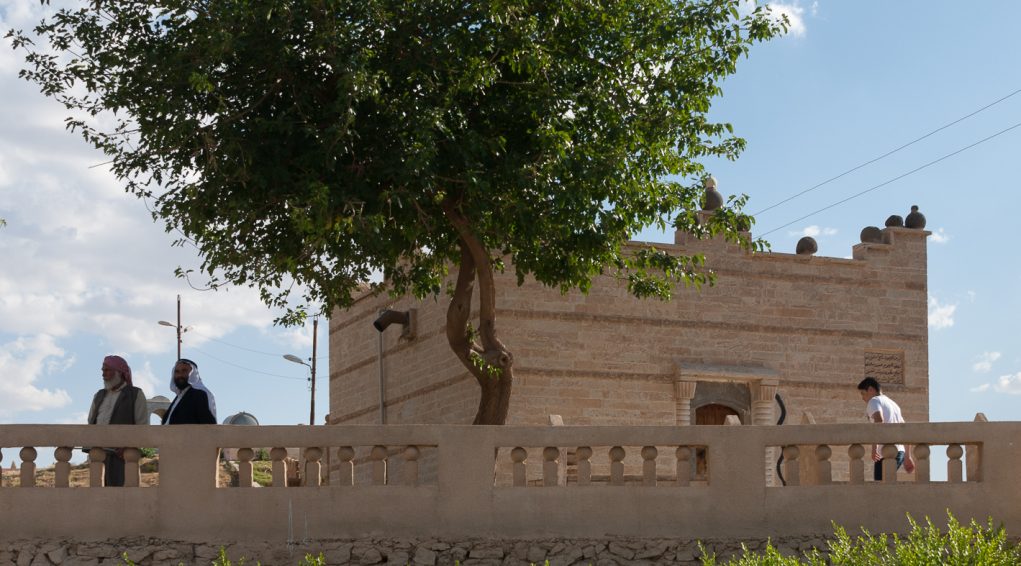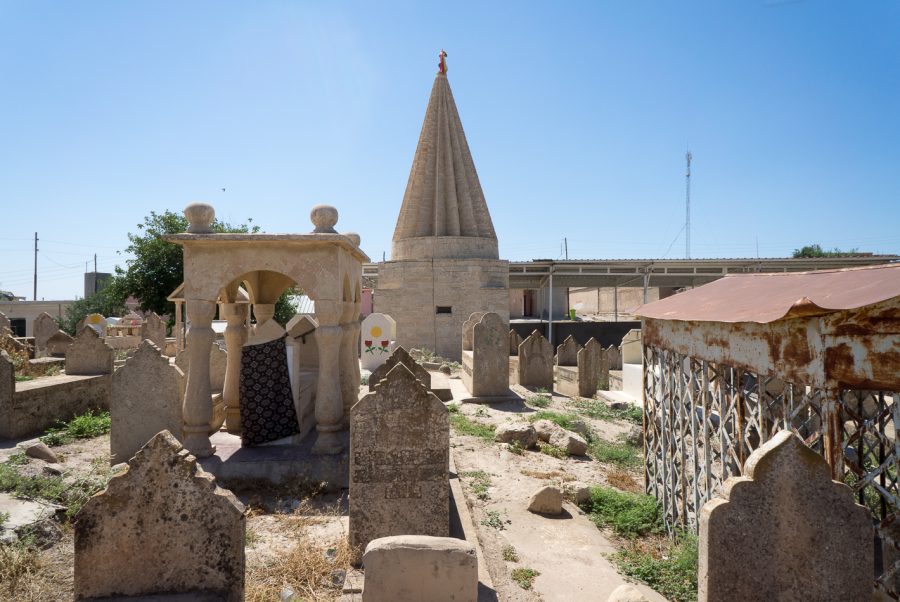The Yazidi mausoleums in Ain Sifni
Aïn Sifni is located at 36°41’30.0″N 43°21’00.0″E and 500 metres altitude in the province of Niniveh, close to the border of Iraqi Kurdistan.
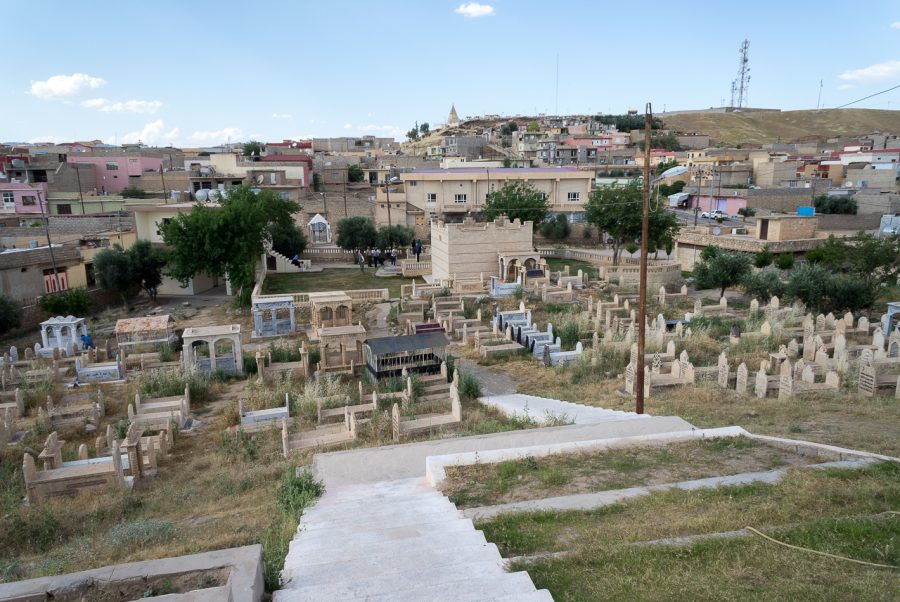
Aïn Sifni is the capital of the district of Shekhan, a major administrative and spiritual centre and the most ancient heritage site of the Yazidi community. This district contains the 50 largest Yazidi villages: Bozan, Lalish, Ba’adrê, Beban and Ain Sifni.[1]
The importance of the village of Ain Sifni is all the greater because it is the home of the Yazidi prince Mîr Tahsin Beg and the Baba Sheikh (the highest Yazidi religious dignitary) and their families.
In the Yazidi belief system, Ain Sifni is also where Noah lived when he built the ark and when the Flood began. In the Yazidi pantheon Noah is second in line after Adam.
There are two Yazidi cemeteries and seven sacred sites in Ain Sifni.
[1]Shekhan
Map of Yazidi Mausoleum of Sheikh Hantuch in Ain Sifni © Dr. Birgül Açikyildiz-Şengül, University of Montpellier III
PICTURE : Yazidi cemetery, cenotaph of Sheikh Mand and the city of Ain Sifni. June 2018 © Pascal Maguesyan / MESOPOTAMIA
About this file
The content of this file has been drafted by Dr. Birgül Açıkyıldız-Şengül, art historian, specialised in Yazidi heritage and culture. Dr. Birgül Açıkyıldız-Şengül is an associate researcher at the University Paul Valéry Montpellier III and the IFEA Istanbul, and is the author of a doctoral thesis: “Yazidi heritage: Funeral architecture and sculptures in Iraq, Turkey and Armenia” presented in 2006 at the University Paris I Panthéon-Sorbonne (department of Islamic art and archaeology). This thesis contains a documented inventory of 88 monuments (sanctuaries, mausoleums, baptistries, oratories, caravanserai, bridges and caves) and 60 funeral sculptures (in the shape of horses, rams, sheep or lions) in northern Iraq, Turkey and Armenia. Thesis published by I.B.Tauris (London, New York), 2010. The text has been enriched with the observations and interviews of the Mesopotamia team (Pascal Maguesyan, Shahad al Khouri, Sibylle Delaître (KTO)) with support from Mero Khudeada.
Location
The Shekhan district is bordered to the north by the district of Amadia, to the south by the district of Bardarash, and the east by the district of Akra, and to the west by the districts of Dohuk-Nohadra and Simele.
The village of Ain Sifni, capital of the district of Shekhan, is located at 36°41’30.0″N 43°21’00.0″E and 500 metres altitude.
It’s located 10 km to the east of Ba’adrê, 13 km to the west of Mahad, 11 km to the south of the Yazidi spiritual centre of Lalish, 29 km to the east of the major Christian city Alqosh, 45 km to the north of the metropole of Mosul.
About the Yazidi in Iraq
Mainly settled in the autonomous region of Iraqi Kurdistan and the Nineveh plain, their geographic birthplace, there are also Yazidi in Turkey, Syria, and the Caucasus in particular in Armenia and Georgia. Generally considered as non-Islamic Kurds, which is at the very a least a simplistic if not inaccurate statement given their mythological origins, often demonised due to their religious practices, the Yazidi are a community whose historical origins and number are difficult to estimate.
Marginalized to the extreme in Iraq under various regimes, their existence was practically denied. Prior to 2003, Baghdad officially only recognised a few thousand whereas in reality there were no doubt closer to hundreds of thousands.
The conditions for an attempted genocide were already in place even before the ISIS jihadis started to massacre and kidnap Yazidi in the Sinjar mountains and province of Nineveh in August 2014.
Although the Iraqi forces and the coalition of resistance groups took back Sinjar in November 2015, the majority of the 500,000 – 600,000 Iraqi Yazidi are still displaced. The persecution they have suffered makes them fear for the future despite the constitutional guarantees afforded to them in 2005.
The territorial roots of Yazidism
Yazidism was founded in a mountainous territory where its inhabitants were protected by the slopes, peaks and caves. Considered sacred by the Yazidi, this territory roughly divides into two distinct regions, east and west of the Tigris, the key Mesopotamian river. To the west is Sinjar: the city, surrounding villages and the mountain range. To the east is the spiritual centre of Lalish, and the key sectors of Shekhan, Bozan, Bashiqa and Bahzani. The vast majority of the Yazidi population (including clergy) are from these regions although there are some scattered Yazidi communities outside of these areas.
For centuries, the Yazidi have preserved their customs and traditions in this region, this territory. This preservation of the past was cruelly undermined to the west of the Tigris in the Sinjar region by the devastating ISIS offensive in August 2014. The extent of the destruction and severity of the genocidal crimes committed severely weakened the Yazidi communities in the Sinjar mountains who previously formed the core of the Iraqi Yazidi population.
Territory, history and heritage
It is in this region, either side of the Tigris, that the Yazidi were able to preserve and develop the characteristic architectural features of their religious buildings which are the main places of worship for the Yazidi faithful.
These buildings are mostly dedicated to the first disciples of the 12th century Yazidi reformer, Sheikh ‘Adî, members of the Chamsani families and families such as Hasan Maman, Memê Rech and Cerwan, as well as the community’s first religious leaders, descendants of Sheikh ‘Adî (members of the Adani family) and certain important Sufi mystics who influenced Sheikh ‘Adî’s teachings, namely Abd al-Qadîr al-Jilani, al-Hallaj et Qedib al-Ban (Qadî Bilban).
However, it would be wrong to conclude that Yazidism is a medieval religion. The paucity of the theological and historical sources available is compensated for by the ancient tradition and mythology which are omnipresent and constantly developing. The Yazidi consider Noah to be one of their most ancient and most illustrious patriarchs. They even claim that he lived in Iraqi Mesopotamia, in Ain Sifni (Shekhan) where he built his ark. The Yazidi historians claim that “the Yazidi religion is very ancient. It goes back to 3,500 years BC.”[1]
The Yazidi have a wide diversity of places of worship and prayer, including cemeteries, mausoleums (mazar) some of which are larger than others (khas / mêr), fire oratories (nîshan), the houses of Sheikhor Pîr, trees, bushes, olive groves, bridges, arches, caves, sacred stones (kevir), springs etc. These monuments, structure and sites dedicated to the Yazidi “saints” constitute a large proportion of the cultural setting of the Yazidi communities and are the tangible, physical manifestation of the Yazidi belief system as a whole.
There is however, one fundamental place which all Yazidi turn to, including the diaspora: the Lalish valley in Iraqi Kurdistan. It is the most sacred place in Yazidism. It is the location of the sanctuary of Sheikh ‘Adî, the great reformer of Yazidism in the 12th century. This valley, its mausoleums and its environment are the centre of gravity of Yazidi spiritual life.
The Yazidi buildings were built at different times. The lack of inscriptions and historical sources make it difficult to date them accurately. The poor quality of some of the more recent restorations makes this analysis even more complex. Furthermore, there do not seem to be specific architectural styles associated with specific periods of Yazidi history which could help to date these buildings. In addition, the same style, derived from a specific model has been used at several times over the centuries and is still in vogue.
_______
[1] Chamo Kassem, inspector of Yazidi schools, specialist in Yazidi religion and culture, Head of Culture and Media, at the Lalish Cultural and Social Centre in Dohuk-Nohadra.
Fragments of Yazidi spirituality and theology
Yazidism is a religion based on tradition and oral history that is both simple and complex at the same time. Simple, because it is not regulated by a constraining liturgy or dogma. Complex, because there is no fundamental theological document underpinning it such as the Torah, the Gospels or the Koran. The Yazidi have two sacred books: the book of revelation “Kitêb-i Cilvê “, and the black book “Mishefa Reş” .
Yazidism is a strictly community-based religion (national). One is born Yazidi, you cannot become Yazidi. There is no evangelizing, inculturation or proselytising. That said, Yazidism is not sectarian. Quite the opposite, altruism is considered to be a cardinal virtue, a spiritual and theological foundation. Any researchers interested in studying Yazidism are therefore warmly welcomed by the community and its clergy.[1]
Yazidism is a monotheism. God is singular and unique. He is the creator of the cosmos and of life. In this, Yazidism shares the same belief as the three main monotheist religions: Judaism, Christianity and Islam. As well as Zoroastrianism.[2]
God is light. He is like the sun which shines on the Earth. That is why the Yazidi systematically face the sun to pray. This is something Yazidism shares with Mesopotamian and Persian Zoroastrianism.
God is good, infinitely good. This is why the Yazidi encourage altruism and always pray firstly for the world and then for themselves.
God is everything and is everywhere. Yazidism is physically and spiritually one with the whole of Creation: cosmic, human, animal, vegetal, and mineral. That is why olive trees whose oil is used for the sacred fire are considered sacred by the Yazidi. Similarly, the angel peacock (tawûsê melek) is the most important of the seven angels (melek) which represent God on earth.
Yazidism believes in the judgement of souls and the last judgement. However, it differs from Christianity in its belief in reincarnation. The dead are buried. Their souls are judged according to the good and evil they have done. Pure souls become beings of light. Impure souls are reincarnated in devalued or bellicose human or animal forms.
_______
[1] « Jean-Paul Roux, who passed away in 2009, former CNRS researcher and head of the Islamic art section of the École du Louvre, considered Yazidism as “a standout religion, an obvious syncretism of popular tradition and reminiscences of the dogma of the major religions’’. La Croix, Claire Lesegretain, 26 April 2010.
[2]Born in Persia, founded by Zarathustra (Zoroaster) in the first millenium Before Christ, Zoroastrianism is monotheist and recognises Ahura Mazdâ as the only God. In this sense Zoroastrianism is fundamentally different from the Mazdaism it is derived from. Mazdaism is polytheist, considering Ahura Mazdâ as the main, but not the only, God. This Persian religion spread as far as India in the form of Vedism.
Yazidi worship
Yazidi worship is not governed by a strict liturgy but constitutes a set of traditional rites and votive practices passed on orally from generation to generation.
The Yazidi generally pray individually, but also gather together as a community at their temples and sanctuaries to listen to qawals, who are both musicians and the gatekeepers and guardians of the Yazidi religion, whose knowledge and practices are passed on from father to son.
The daily prayer, facing the sun, the light of God (Khoda), is not an obligation nor is it required to show you are a “good” Yazidi. However, pious, elderly people pray regularly, up to five times a day.
Kissing sacred places and the hands of saintly figures, offering gifts to consecrated persons, sacrificing animals, knotting and unknotting fabric on wish trees, are all signs of respect and devotion.
Wednesday is the most important day in the week. It is like Sunday for Christians, Saturday for Jews and Friday for Muslims. The main weekly services during which the Yazidi monks light the sacred fire in the mausoleums are held on Wednesdays.
Four major annual festivals are held during the Yazidi religious year. The first is the New Year (ser sal) celebrated on the first Wednesday of the month of April. This festival symbolises the creation of life out of the initial chaos and the coming of tawûsê melek. Eggs, a symbol of the original lifeless earth, are boiled and dyed as part of the celebrations. Some of these eggs are smashed above the doors of houses and mausoleums, mixed in with small red flowers.
Another major annual festival is the Spring festival (towaf), which is held on a date between 12th – 20th April. Finally, the pilgrimage to the tomb of Sheikh Adî, in the Lalish sanctuary (djamaiya) takes place on 6th October.
The mausoleum with a conical dome: characteristic Yazidi architecture
Mausoleums with a conical, striped dome are emblematic of Yazidi sacred art. Extremely sober in terms of its architecture and decoration, this type of building is built on a cube structure which contains the tomb or cenotaph, covered by a slab with a drum, above which stands a conical dome composed of multiple crests. This vault symbolises the sun’s rays which light up the earth and humanity.
The pinnacle of the dome is systematically fitted with a bronze spire formed of one or more spheres, mounted with a ring, a crescent moon, and a celestial body or hand, around which swathes of coloured fabric are knotted. The spire represents the cosmos, the planets, the sun and the stars created by God. The coloured fabrics represented the colours of the rainbow. [1]
The interior of a Yazidi mausoleum is often composed of a separate chamber containing a sarcophagus covered in silk fabrics. There are also often several niches carved into the walls to burn incense and light the sacred fire. These often also contain knotted fabrics placed there by pilgrims making wishes.
The sacred space in any Yazidi mausoleum includes the slab in front and around it. That is why any visitor or pilgrim must remove their shoes.
_______
[1]This interpretation can vary from one community to another.
Recent history and Yazidi demography in Ain Sifni
Aïn Sifni is the capital of the district of Shekhan, a major administrative and spiritual centre and the most ancient heritage site of the Yazidi community. Located at the crossroads between Iraqi Kurdistan and the Nineveh province, this district contains the 50 largest Yazidi villages: Bozan, Lalish, Ba’adrê, Beban and, of course, Ain Sifni.
The importance of the village of Ain Sifni is all the greater because it is the home of the Yazidi prince Mîr Tahsin Beg and the Baba Sheikh (the highest Yazidi religious dignitary) and their families.
In the Yazidi belief system, Aïn Sifni is also where Noah lived, where he built his ark and where the Flood began before it landed on Mount Judi. In the Yazidi pantheon Noah occupies the second place after Adam (idem Y007). Aïn Sifni is one of the most important Yazidi spiritual centres.[1]
In the previous century, in the 1930s and 1940s, there were only Yazidi and Jews living in Shekhan (Ain Sifni). Most of the surrounding villages were populated with Yazidi. This is not the case today.
In 1975, Ain Sifni was hit by Saddam Hussein’s Arabisation policy. All the Yazidi families in Ain Sifni were forced to move to Mahad which was transformed into a single urban entity housing the 13 Yazidi villages in the surrounding area. When Saddam Hussein’s regime collapsed in 2003, the Arab colonizers in Shekhan left the village of Ain Sifni and all the villages they occupied in the district. The inhabitants of Ain Sifni returned to their homes, took back their houses and heritage, renovated and restored what was destroyed and constructed new buildings.
A decade later a new catastrophe arose in the form of ISIS. The Yazidi were persecuted and were victims of a genocide in Sinjar, to the west of the Tigris. ISIS’s sweeping onslaught was contained the west of the Tigris to the Nineveh plain. All the Yazidi villages bordering Iraqi Kurdistan were temporarily evacuated as a preventive measure. This was also the case in Ain Sifni.
Before ISIS, there were 700 families in Ain Sifni. 80% were Yazidi, 10% Christian and 10% Muslim. In 2018, only 200 families remained![2]
_______
[1]Mount Judi has been identified as a mountain located at 2089 metres altitudeon the Turkish, Syrian, Iraqi borders, close to Silopi in Turkey. Mount Judi is not Mount Ararat where the mythology and tradition situated the grounding of Noah’s ark.
[2]Data collected in Shekhan (Ain Sifni) by the Mesopotamia team on 5th June 2018, from Yazidi community leaders.
Testimony of Azad Mourad Hadji: the situation for the Yazidi after ISIS
“We never expected to face a genocide in August 2014! Our situation today can be summed up in two sentences. 80% of people are currently living in tents. There are 60 – 70 mass graves (cemeteries?) that no one seems concerned about. There are women, men and children there whose bodies (bones?) are being searched for.
In the 21st century, 3,000 Yazidi women and girls are still in the hands of ISIS. We know nothing about their fate.
It is also very important to say that in three years 100,000 people (Yazidi) have emigrated to Germany, Belgium, the United States, Canada and Austria. Today there are sisters who no longer see each other, father who no longer see their children. The social relationships have been broken.
For those who remain here, the situation is not safe because the attitudes of ISIS are still very present. The security situation is poor. Many young boys, girls and women have psychological problems.”
Sacred Yazidi sites in Ain Sifni
In Ain Sifni there are seven scared Yazidi sites, including three traditional mausoleums with conical domes and four other buildings including the cenotaph of Sheikh Mand. Two mausoleums are particularly well known and visited by large numbers of Yazidi worshippers. The mausoleum of Sheikh ‘Alî Chams and the mausoleum of Sheikh Hantuch.
The mausoleum of Sheikh ‘Alî Chamse. This stands on a high hill which overlooks the village of Ain Sifni. The mausoleum is surrounded by a cemetery. It is in good condition and is the most precious building in Ain Sifni. We have no information on the date of this building’s construction nor on Sheikh ‘Alî Chamse himself. However, we consider Sheikh ‘Alî Chamse to be one of the nine sons of Sheikh Chams who is said to have lived in the 14th century. As regards the floor plan of the mausoleum, it is characteristic of Mosul architecture which appeared in the 12th century and was used up until the 15th century in the north of Iraq by Shia Muslims and Yazidi at different periods. This suggests the building dates from the 15th century but it is impossible to be any more accurate than this.
The mausoleum has a square floor plan, measuring 4.9 x 4.9 metres, overlooked by a conical, crenelated dome. The drum has three steps: the first is octagonal, and the other two circular. The conical dome is composed of 28 sections and is crowned with two metallic spheres “hilêl” adorned with fabrics. The interior accessed via a small door in the north wall. There are three small rectangular windows in the octagonal drum. There are two niches in the eastern wall, two others in the west wall and one in the south wall. The latter is used to light wicks. The casket of Sheikh Alî Şemse is placed in a north-to-south direction to the left of the entrance.
The building is built of breeze blocks jointed with gypsum mortar (juss). The facades, and the conical dome, were clad with cut stone as part of a recent restoration project.
The mausoleum of Sheikh Hantuch. This mausoleum is situated in the countryside, at a distance from the village of Ain Sifni. According to Pr. Philipp G. Kreyenbroek, Sheikh Hantuch was one of the first disciples of Sheikh ‘Adî in the 12th century (1072-1162). The mausoleum’s architecture has many of the characteristics of 12th and 14th century Mosul. It is therefore possible that this mausoleum dates back to the 12th century.
It has a square base and is crowned with a conical dome with multiple crests. Its dimensions are 3.2 x 3.2 metres. The interior is accessed via a door located on the north wall. There is a rectangular niche in each wall except for the north wall. The walls are thick (1.3 metres width). On the inside, the dome is mounted on four squinches. The drum of the mausoleum on the outside has two levels. The first level is octagonal and the second circular. The dome and cupola are composed of 24 sections topped with a sphere.
The Sheikh Mand memorial This memorial is found at the centre of the Ain Sifni village in a cemetery. It is not strictly speaking a mausoleum at all but is in fact a cenotaph i.e. a memorial with no body buried. According to Sharaf Khan Bidlisî, Sheikh Mand was one of the Kurdish emirs from Antioch and Aleppo in Syria, in service to the Ayyoubide dynasty. Sheikh Mand is revered for having resolved the Yazidis’ problems when he was in power in Syria in the 13th century. In the Yazidi belief system, Sheikh Mand is also said to have power over snakes. Several cenotaphs bear his name, notably in Bozan, Kabartu and, of course, here in Ain Sifni. His mausoleum is in Lalish.
The Sheikh Mand memorial takes the form of a small square citadel supposed to represent in miniature the citadel of Aleppo where Sheikh Mand reigned. The building is covered in cut stones. The roof is flat. The walls are mounted with ornamental merlons and large stones shaped like balls. The wooden entrance door is framed by two load-bearing columns decorated with horizontal ribbing. To the right of the door is a sculpted snake painted black.[1][2]
Inside is an altar for prayer and sacred objects used in the holy fire ceremony. The building is surrounded and outlined by a tiled floor which is part of the sacred space, any visitor or pilgrim must remove their shoes before entering. To the sides and behind the building, the cemetery is full of beautiful Yazidi tombs from a variety of periods.[3]
Although the date of construction of the cenotaph cannot be accurately determined, the building was restored in 2001, as attested to in an inscription on the facade of the building. However, the Yazidi representatives in Ain Sifni claim the cenotaph is close to 950 years old!
_______
1][2]The only explanation given to the Mesopotamia representatives on 5th June 2018 is that they represent the balls used in catapults in the past. We would suggest that this interpretation is taken with caution.
(idem texte notice Y007) During the Flood the wooden hull was pierced by a rock. A hole formed and the water came flooding in, threatening to sink the ship. At this point a black serpent curled up and filled the hole, saving the passengers and thus the whole of humanity. The Yazidi have honoured the black snake ever since for its devotion and wisdom. The black snake is therefore a very important animal in Yazidi mythology and is often represented on monuments.
[3]It was not possible to visit inside the cenotaph on the day the Mesopotamia delegates visited on 5th June 2018.
Monument's gallery
Monuments
Nearby
Help us preserve the monuments' memory
Family pictures, videos, records, share your documents to make the site live!
I contribute